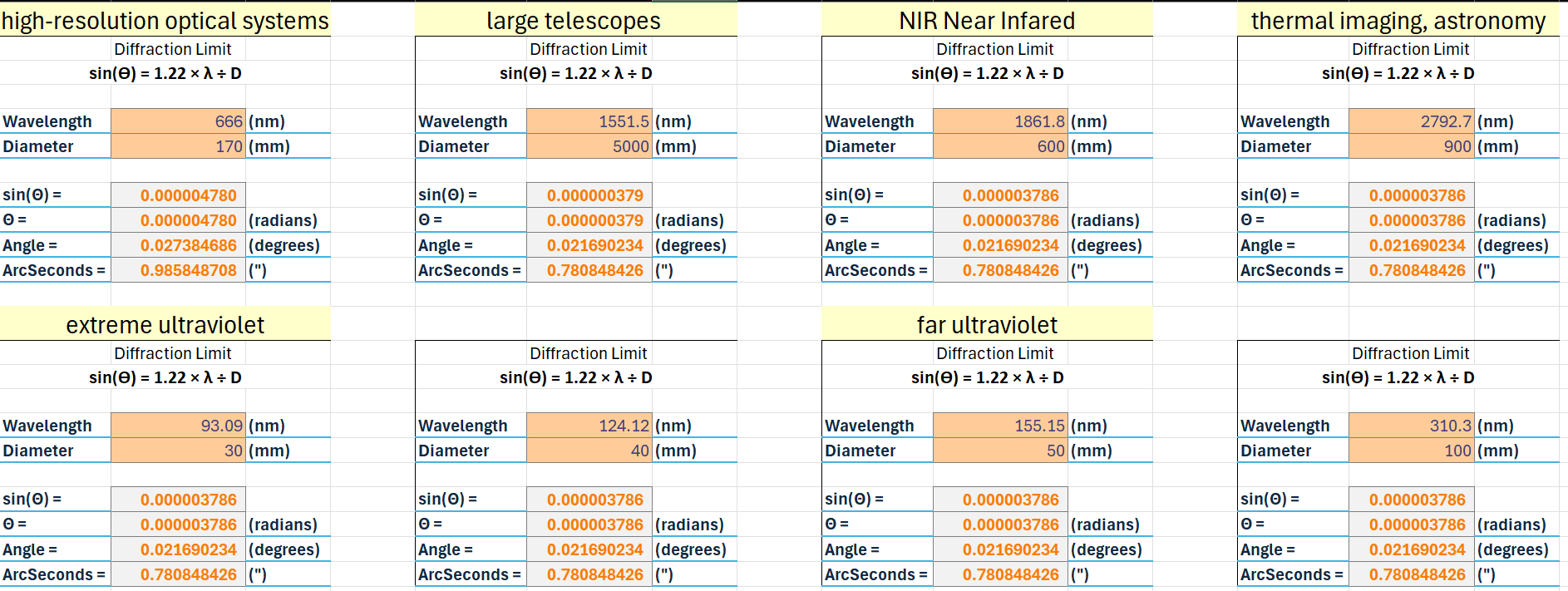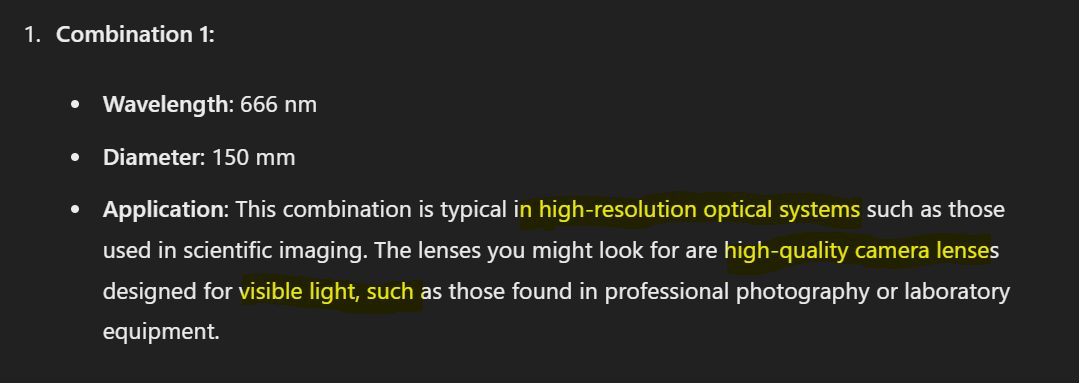[Bottom up obstruction on a level plane](https://publish.obsidian.md/shanesql/Bottom+up+obstruction+on+a+level+plane)
[Optics Derived](https://publish.obsidian.md/shanesql/Attachments/Optics+Derived+.docx)
Angular Resolution and our World
[https://publish.obsidian.md/flatearth/Angular+Resolution+and+our+World](https://publish.obsidian.md/flatearth/Angular+Resolution+and+our+World)
[https://www.youtube.com/watch?v=aVAWQGlXRWg](https://www.youtube.com/watch?v=aVAWQGlXRWg)
Bottom up obstruction on a level plane
[https://publish.obsidian.md/flatearth/Bottom+up+obstruction+on+a+level+plane](https://publish.obsidian.md/flatearth/Bottom+up+obstruction+on+a+level+plane)
Have you ever seen Earth curve and distance dependent angular resolution in the same frame at the same time ? ~={cyan}What if they are the same thing? =~
We all know there is an apparent drop proportionate to distance. The mainstream position is that this bottom up obstruction is caused by the geometric physical earth curve. The counter position has always been that his effect is optical in nature, and not due to physical earth curve.
What it comes down to is this: The loss of information at our horizon is either optical, or physical.
If it's physical, things will simply disappear over the horizon.
If it's optical, things will disappear by angular resolution limit of the observer.
We are trying to use math to distinguish which is true.
Our argument:
If earth curve is actually physical, why can I use the values of optical limits of perception to derive the supposed radius of earth to the 8th decimal place?
The loss of information at our horizon is either optical, or physical (or both).
Well lets look at the values we chose to use, and why we chose them.
These are the values we used.
Wavelength = 666 nm
Diameter = 2.16mm
Why did we choose these values?
Well, because they represent the most commonly experienced circumstances of course.
The diameter of the Pupil (typically) ranges from 2-4 nm to 4-8nm, and it narrows the further out you look.
Wavelengths of light vary on a scale, with atmospheric scattering scaling low to high with refraction scaling high to low with the wavelength.
We chose 2.16mm because the furthest field would be most dilated.
We chose orange/red because they are LEAST susceptible to refraction.
Since the angular resolution limit and the expected rate of drop due to distance are two factors that will ALWAYS yield the radius, how can we now conclude that this value is NOT based on optics?
It seems there is now a huge disparity in the amount of evidence for physical curvature VS optical curvature....
I wonder if anyone will ever find any?
I wonder if some glober will present some math to counter the derived the radius with a higher degree of accuracy than 8 decimal places?
I wonder which side is right?
The question is:
Why, when given any 2 values of these 3, you can ALWAYS derive the 3rd?
What sort of relationship does that imply?
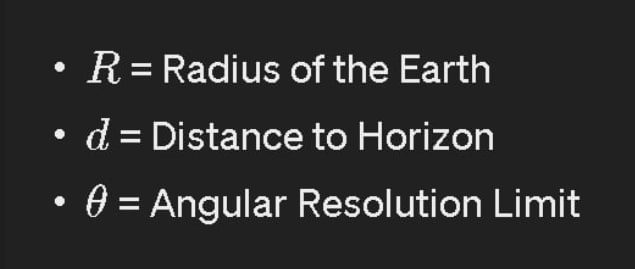


%201%201%201%201%201%201%201%201%201%201%201.png)
##### Anatomical Parts of the Eye:
1. **Ciliary Muscle**:
- A ring of smooth muscle in the eye's middle layer (uvea) that controls the shape of the lens, allowing the eye to focus on objects at varying distances.
2. **Canal of Schlemm**:
- A circular channel in the eye that drains aqueous humor from the anterior chamber into the bloodstream, helping to maintain intraocular pressure.
3. **Zonular Fibers**:
- Also known as the suspensory ligaments of the lens, these fibers connect the ciliary body to the lens, holding it in place and adjusting its shape for focusing.
4. **Iris**:
- The colored part of the eye, which controls the size of the pupil and, thus, the amount of light entering the eye.
5. **Optic Axis**:
- An imaginary line that passes through the center of the eye's lens system and is perpendicular to its surface, aligning with the point of focus on the retina.
6. **Visual Axis**:
- The line connecting the center of the fovea (the point of sharpest vision on the retina) with the object being viewed.
7. **Lens**:
- A transparent, flexible structure behind the iris that focuses light onto the retina by changing its shape through accommodation.
8. **Anterior Chamber**:
- The fluid-filled space between the cornea and the iris, containing aqueous humor that nourishes the eye and maintains intraocular pressure.
9. **Hyaloid Canal**:
- A narrow, transparent canal running through the vitreous humor from the optic disc to the lens; it is a remnant of fetal development.
10. **Vitreous Humor**:
- The clear gel that fills the space between the lens and the retina, providing the eye with its shape and optical properties.
11. **Sclera**:
- The white, opaque, fibrous outer layer of the eyeball that provides protection and structure.
12. **Retina**:
- The light-sensitive layer of tissue at the back of the eye that converts light into electrical signals, which are sent to the brain via the optic nerve.
13. **Pigment Epithelium**:
- A layer of cells located between the retina and the choroid, responsible for nourishing retinal visual cells and absorbing scattered light.
14. **Choroid**:
- The vascular layer of the eye, containing connective tissue and blood vessels, located between the retina and the sclera, supplying oxygen and nutrients to the retina.
15. **Optic Nerve**:
- A bundle of nerve fibers that transmits visual information from the retina to the brain.
16. **Optic Disc**:
- The point on the retina where the optic nerve fibers exit the eye; also known as the "blind spot" because it lacks photoreceptors.
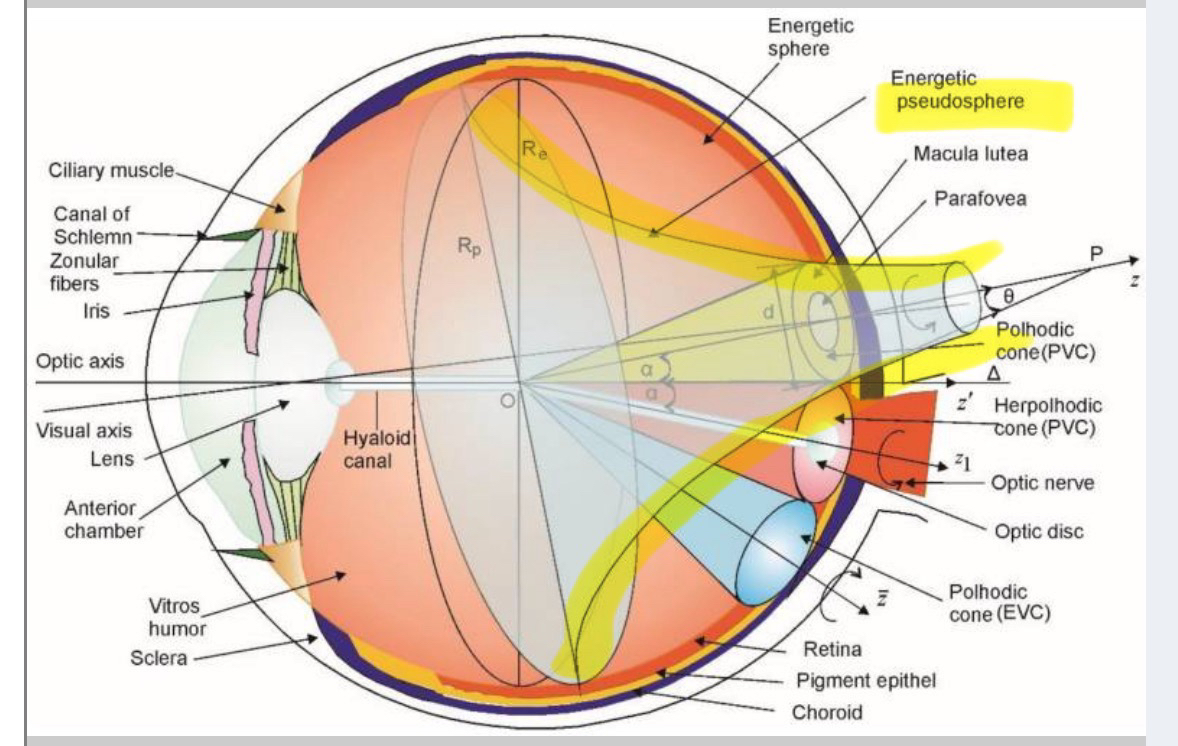
%201%201%201%201.png)


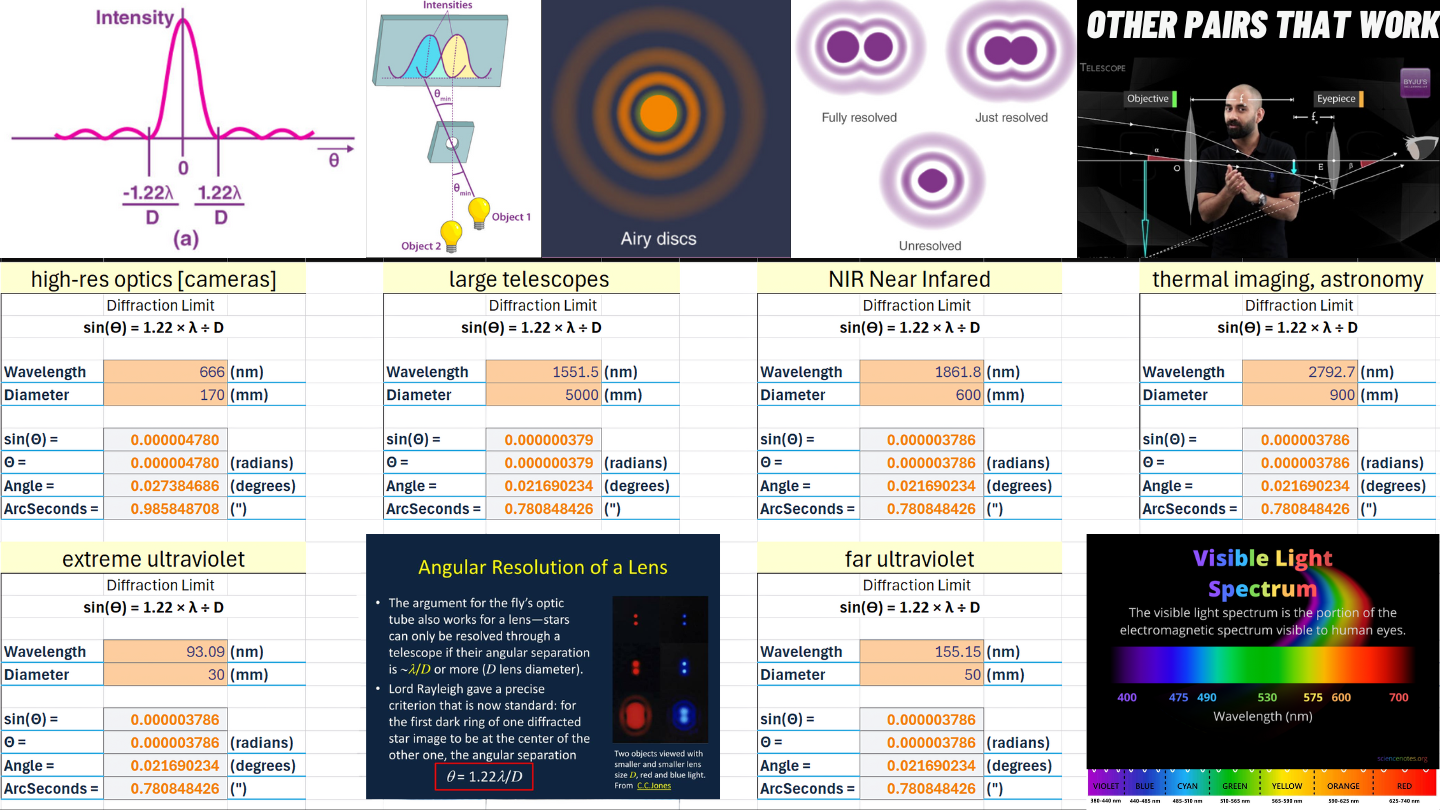
The relationship between the factor 1.22 and the horizon distance on Earth creates a fascinating mathematical coincidence. The spreadsheet demonstrates two independent calculations that yield nearly identical distances:
## Diffraction Limit Calculation
Using the Rayleigh criterion:
θ=1.22λDWith:
- λ = 666 nanometers (orange-red light)
- D = 2.16 millimeters (pupil diameter)
- Height = 1.8 meters
This yields a diffraction limit distance of approximately 4785.11 meters.
## Horizon Distance Calculation
Using the curvature horizon formula:
Distance=2RhWhere:
- R = 6372 kilometers (Earth radius)
- h = 1.8 meters (observer height)
This yields a horizon distance of approximately 4789.49 meters.
## The Coincidence
The nearly identical results (difference of only about 4 meters) suggest that the human eye's diffraction limit at sea level coincides almost perfectly with the geometric horizon distance. This means that the theoretical limit of what we can resolve due to light diffraction matches the physical limit of what we can see due to Earth's curvature.
This remarkable alignment between optical physics (1.22 factor) and geometric reality (Earth's radius) suggests a natural optimization in human vision evolution, where our eyes' resolving power matches what we actually need to see at the horizon.
#### How the Mean Radius of Earth was Extrapolated from the Limitations of the Human Eye to Invent the "Globe"
This is basic demonstrable scientific information that we all SHOULD have been taught, but weren't - why? Because this is how they created the ILLUSION in our minds...
Yes, this is technical and requires diligent thought - "they" put a lot of effort in hiding the True Cosmology and creating the illusion which so many now believe; it's going to take similar effort to unravel how they did it. We either believe in highly improbable coincidence, or we accept that the following is precisely what they did to fool us.
The Angular Resolution Limit of the human eye is approximately between 0.02deg and 0.03deg. Optical information loss occurs when the angular size of an object is smaller than the Angular Resolution. This angle, at 0.0217062deg, and an assumed light wavelength of 666nm was used to derive the radius of earth. The occultists who gaslighted us love 6's and 9's in their occult numerology** - we had to think like them to figure out what they did - and here it is: ~={red}The horizon gain for a 6ft observer across 0.0217062deg was inverted as height/information loss across the same angle, and the two angles were used to construct a spheroid/globe with a tilt angle of 0.0434124deg=~. This angle represents the 6’ drop from a 6’ observer across the average horizon distance of 2.999547 miles, and it was extrapolated near/far to derive the radius of a sphere. See video linked below, (Angular Resolution and Our World), for a more detailed explanation with visuals.
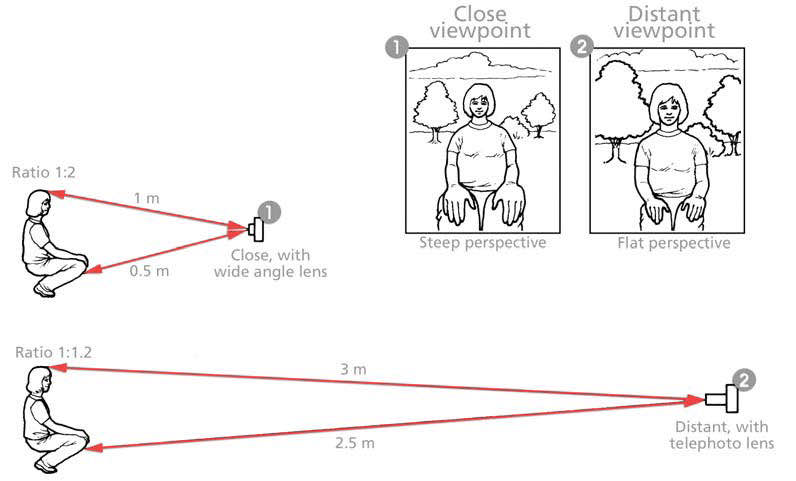
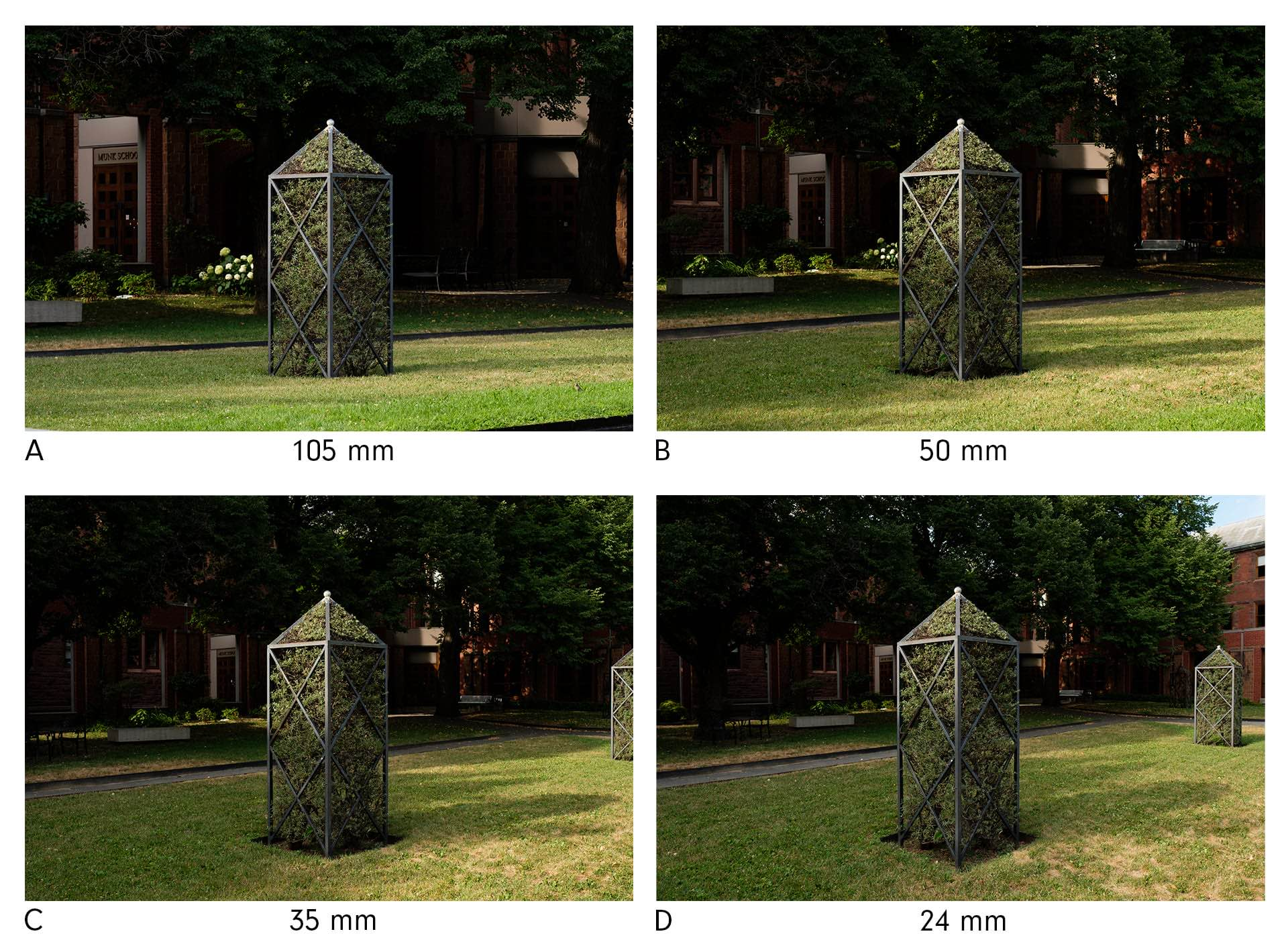
Basically what this is saying is; if you are a 6 foot tall person standing on the shoreline looking out to sea; the horizon would appear at 2.999547 miles in the center of your vision. This is true regardless of Flat or Spheroid earth.

The question is: Is the loss of information (bottom clipping), that we observe at the horizon - is it an optical phenomenon caused by the limitations of our eyes and devices used to view through, OR, is it a physical phenomenon caused by the claimed curvature of earth?

~={red}The Answer: By using this known limitation information of the human eye, "they" were able to construct a seemingly realistic "globe" earth model which would appear as such to the untrained observer=~ - knowing at the time, which we assume to be somewhere in the 1800's, that most did not have availability or affordability of having high resolution optical devices like telescopes to zoom back in what they told us went over the curvature... Those high resolution optical devices were mainly used by the Military, Astronomer science's or the wealthy and was not a common easy to obtain item as it is today.
So when someone in the 5 to 6 feet tall range stood on the shoreline, what they observed as ships sailed away was that ships appeared to disappear from the bottom up - not realizing that the actual cause is because they had the average human Angular Resolution eye sight - but assumed that it was caused by the "curvature" of a spheroid earth simply because someone in a position of authority said so - which is a Logical Fallacy called, Appeal to Authority Fallacy; in other words, we believed it on pure FAITH - not "science".
We seem to have fallen for this many times over in various other sciences too - including medical science where most people sadly believe they get sick from tiny invisible particles called "viruses" and that big pharma "vaccines" are the solution - yet another delusion from the pit of hell and the rulers of evil. But I digress...
We are going to correct the "globe" fallacy right here and reveal how "they" were able to gaslight everyone over time to ignore their own senses and good reason to believe that they lived on a spinning spheroid/globe. There should be an, "ah HA!" moment in here for most of you.
Let's see how they Gas-lit everyone:
The angular resolution or spatial resolution of an optical system can be estimated by Rayleigh's Criterion. When two point sources are resolved from each other, they are separated by at least the radius of the airy disk. When Theta = 1.22 * (W/d) rad ,
where Theta is the angular resolution, W is the wavelength of light and d is the diameter of the eye. Airy Disk defined: [https://en.wikipedia.org/wiki/Airy_disk](https://en.wikipedia.org/wiki/Airy_disk)
[Attachments/Pasted image 20240328221023.png](https://publish.obsidian.md/shanesql/Attachments/Pasted+image+20240328221023.png)
The Reality: The distance to the horizon viewed by 6 foot tall person(P1) would be at 2.999547 miles - meaning that if another 6 foot tall person(P2) was 2.999547 miles in the distance, the top of P2's head would be just barely hidden behind the horizon from the viewpoint of P1. The reality is that there is no curvature hiding P2;~={red} it's only that at 2.999547 miles that P1's Angular Resolution limit has been reached concerning an object the size of another 6 foot tall person. (as shown in the figure above)=~
How "they" did it: The Formula: R(radius of earth) = d/(tan(2Theta))
The Given: The following is how they derived it:
Using a realistic human eye Angular Resolution limit of: 0.0217062
Thus making: 2Theta = (0.0217062 x 2) = 0.0434124
d = Distance to Horizon = 2.999547 miles
The Math:
R = 2.999547/(tan(0.0434124))
R = 3958.8078674061 miles
Compare to the officially published mean radius of earth: The "globe earth's" officially stated radius is 6371km or 3958.8miles. [https://en.wikipedia.org/wiki/Earth](https://en.wikipedia.org/wiki/Earth)
d2=0.666h
leading to d=1.22h
Where 𝑑d is the distance to the horizon (in miles) and ℎh is the height of the observer (in feet). This formula calculates how far away the horizon appears based on the height of the observer above the Earth's surface.
.png)
A coincidence you say? Think again. What I just explained here; is specifically how they used our own human limitations to intentionally deceive us - this is called Sorcery or Witchcraft - The using of "spells", aka the manipulation of words, and/or concepts outside of their proper, truthful and intended usage in order to create a deceptive illusion for the purpose of the control of the masses by hoarding real knowledge, which is called, "Gnosticism" - and personally, I believe "they" do it to hide the obvious creation of God from us, and even God Himself, and then provide us with nonsensical ideas like Billions of years, Big Bang chaos magical spinning water-rock cosmology and Darwinian Evolution in truth's place. So "they" did all that - and then taught that earth was a ball with a 3959 mile radius and also taught that when you see something disappear in the distance from the bottom up, that it's because of the curvature of earth - rather than teach us the Physics of Optics which states that what we observe at distances is mainly determined by our human Optical Limitations of Angular Resolution, the Refraction and Lensing from the density and temperature of the fluid of the air and particles being viewed through; and the mostly untaught phenomena of how Perspective works on our vision - which you can find explained in great detail on LifeIs Short's channel(link below). There is no doubt that this is precisely what the Rulers of Evil used to derive their imaginary radius of imaginary "globe" earth from. Crafty!
This science was intentionally not taught to most of us - and for good reason; many of us would have figured out we don't live on a spheroidish/globe as far back as High School. Had we known all of this, especially nerds like my cousin and myself who would intentionally miss the bus and instead of going home from school we would holdup the Physics teacher and pick his mind about how everything in the world works. I know, right! Nerds...
The bottom line is - that IF you pre-assume a spheroid earth, then the perceived curvature is actually only your own eyes which are being aided by a false mental paradigm. Once we realize how they manipulated us with hidden knowledge of the Physics of Optics and the limitations of the human eye, we are then free to view the world with knowledge, logic and reason.
Special Thanks to LifeIs Short youtube channel (@lifeisshort4456): Angular Resolution and Our World [https://www.youtube.com/watch?v=aVAWQGlXRWg](https://www.youtube.com/watch?v=aVAWQGlXRWg)
His University Level lecture style presentations on the Physics of Optics called "A Concept For Vision" are second to none and I highly recommend taking the time to study them. Once you know what you are really looking at and why—they can't fool you anymore.
Also, another excellent and very helpful video: Ultimate Guide To Refraction, Sunsets, Claimed Curvature & More [https://www.youtube.com/watch?v=pfybtObSwAo](https://www.youtube.com/watch?v=pfybtObSwAo)
**Note: Notice that each of the main numbers, Angular Resolution, Distance to Horizon, and Radius, all reduce to their favorite occult number, 9 - just remember that this is how they operate and what they believe as can be seen in so many other numbers they provide us, like 23.4 degrees alleged "tilt" (which is 90 degrees minus 23.4 = 66.6degrees), or the alleged orbit of earth being 66,600 mph, and so on - , it's their religion - and when you're watching their Predictive Programming entrainment(entertainment) shows and movies, you'll begin to see their numerology hidden in plain sight (along with the globes supporting role in nearly every movie) - 6's(which they consider inverted nines...), 9's, 11's, 33's, 23, 13, 216, 55, 46, 47... They literally believe that it makes their manipulative "magic" work - they tell us as much in their own occult writings; no need to make this up.
.jpg)
.png)
.jpg)


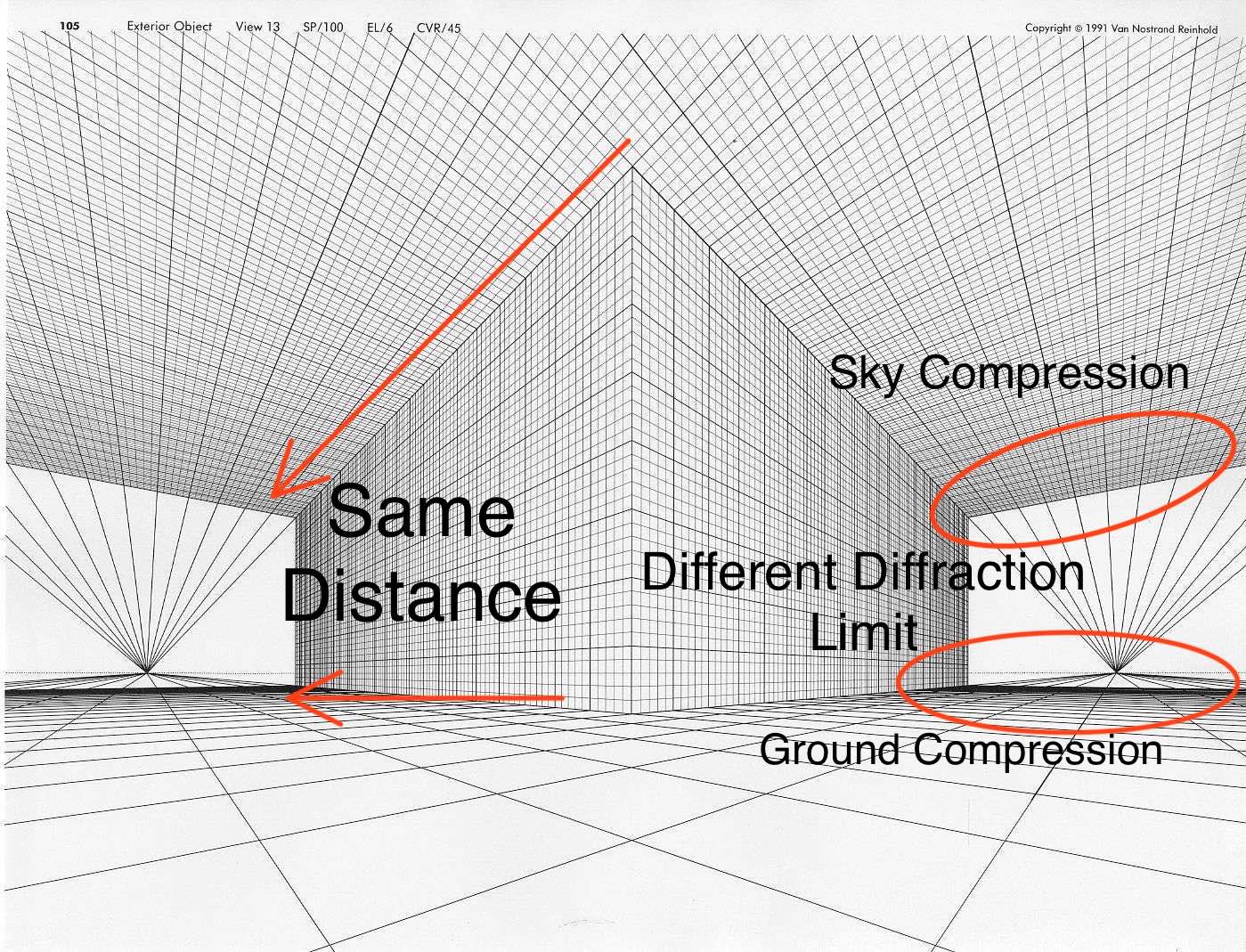

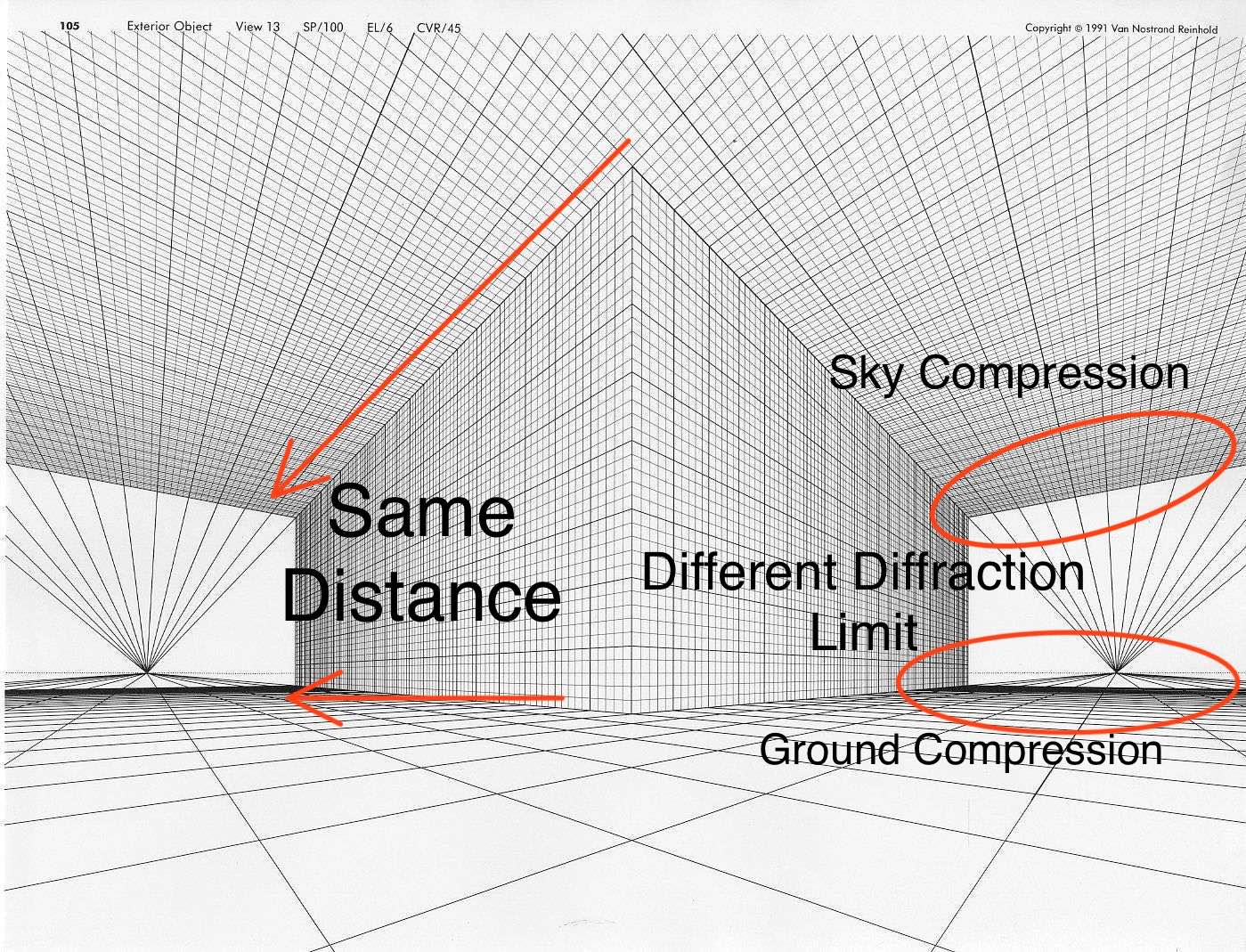
[https://planegeodesy.com/perspective-applied-to-an-outward-bound-ships-hull-and-masthead](https://planegeodesy.com/perspective-applied-to-an-outward-bound-ships-hull-and-masthead)

.jpg)
### Main Formula and Explanation:
- **h₁ / h₂ = d₂ / d₁**
- This relationship shows how the change in height (h) is proportional to the change in distance (d).
- The equation means that if you increase your height (h₂ compared to h₁), you proportionally increase the visible distance (d₂ compared to d₁).
- **h₁** and **h₂** are the heights (the observer's position or the object's height), and **d₁** and **d₂** are the respective distances at those heights.
- Essentially, this equation expresses that the ratio of heights is equal to the ratio of distances, showing a direct proportionality between height and distance.
### Example Provided in the Image:
The example talks about a person standing 6 feet high and observing a boat at 3 miles away. The boat disappears from view at that distance. When the person increases their height from 6 feet to 18 feet, this 200% increase in height allows them to see the boat at a farther distance (9 miles instead of 3 miles).
- **Initial setup:**
- When the observer is 6 feet high (**h₁ = 6**) and the boat is 3 miles away (**d₁ = 3**).
- When the observer increases their height to 18 feet (**h₂ = 18**), the visible distance increases to 9 miles (**d₂ = 9**).
### Linear Relationship:
- The explanation notes that this is not due to the curvature of the Earth (suggesting this may be used in a flat-Earth discussion or in the context of perspective).
- The claim is that the increase in height allows you to resolve more information (due to resolution angles), which were previously compressed.
### Explanation of the Proportionality:
- The proportionality between height and distance is described as:
h∝d1
This means that the height is inversely proportional to the distance, but when considering the total visual field, increasing height increases the visible distance in a proportional way, as expressed by the formula **h₁/h₂ = d₂/d₁**.
---
### Example Breakdown:
- The boat disappears at **d₁ = 3 miles** when the observer is at **h₁ = 6 feet**.
- The observer then raises to **h₂ = 18 feet** (a 3x increase in height).
- The visible distance extends to **d₂ = 9 miles** (also a 3x increase in distance).

Reader, many banal arguments historically cited in favour of the earth’s alleged sphericity or spheroidicity were categorically debunked in the nineteenth century book titled, _Zetetic Astronomy: Earth Not a Globe_ by Samuel Birley Rowbotham (who wrote under the _nom de plume_ known as “Parallax”).[**1**](https://planegeodesy.com/perspective-applied-to-an-outward-bound-ships-hull-and-masthead#fn1)
Our focus here will be restricted to Chapter XIV of Rowbotham’s book, and more specifically to the early part of that chapter pertaining to the “disappearance” of the hull of an outward bound vessel before its masthead.[**2**](https://planegeodesy.com/perspective-applied-to-an-outward-bound-ships-hull-and-masthead#fn2)
Rowbotham’s opening paragraph really sets the proper tone for his examination of this matter and is therefore quoted as follows in its entirety:
It has already been proved [elsewhere in Rowbotham’s book] that the astronomers of the Copernican school merely assumed the rotundity of the earth as a doctrine which enabled them to explain certain well-known phenomena. “What other explanation can be imagined except the sphericity of the earth?” is the language of Professor de Morgan, and it expresses the state of mind of all who hold that the earth is a globe. There is on their part an almost amusing innocence of the fact than [sic] in seeking to explain phenomena by the assumption of rotundity, another assumption is necessarily involved, viz., that nothing else will explain the phenomena in question but the foregone and gratuitous conclusion to which they have committed themselves. To argue, for instance, that because the lower part of an outward-bound vessel disappears before the mast-head, the water _must_ be round, is to assume that a _round surface only_ can produce such an effect. But if it can be shown that a simple law of perspective in connection with a plane surface necessarily produces this appearance, the assumption of rotundity is not required, and all the misleading fallacies and confusion involved in or mixed up with it may be avoided.[**3**](https://planegeodesy.com/perspective-applied-to-an-outward-bound-ships-hull-and-masthead#fn3)
The critical aspect of visual perspective necessary for understanding the disappearance of the hull of an outward bound ship before its masthead is elucidated by Rowbotham as follows:
The erroneous application of perspective already referred to[**4**](https://planegeodesy.com/perspective-applied-to-an-outward-bound-ships-hull-and-masthead#fn4) is the following:—It is well known that on looking along a row of buildings of considerable length, every object _below_ the eye appears to _ascend_ toward the eye-line; and every thing _above_ the eye appears to _descend_ toward the same eye-line; and an artist, wishing to represent such a view on paper, generally adopts the following rule:—draw a line across the paper or canvas at the _altitude of the eye_. To this line, as a vanishing point, draw _all other lines_ above and below it, irrespective of their [vertical] distance, as in diagram 75 [see **Figure 1** below].[**5**](https://planegeodesy.com/perspective-applied-to-an-outward-bound-ships-hull-and-masthead#fn5)
**Figure 1.** Illustration of height-dependent perspective (adpated from Rowbotham’s untitled Fig. 75).[**6**](https://planegeodesy.com/perspective-applied-to-an-outward-bound-ships-hull-and-masthead#fn6)
Rowbotham continues:
Let AA, BB, and CC, DD, represent two lines parallel but not [vertically] equi-distant from the eye-line EE, HH. To an observer at EE, the vanishing point of CC, DD, and EE, HH, would come together at HH, at an angle of _one minute_ of a degree.[**7**](https://planegeodesy.com/perspective-applied-to-an-outward-bound-ships-hull-and-masthead#fn7) But it is evident from a single glance at the diagram that HH cannot be the vanishing point of AA, BB, _because_ the distance EE, AA, being greater than EE, CC, the angle AA, HH, EE, is also greater than CC, HH, EE—is, in fact, considerably _more_ than one minute of a degree.[**8**](https://planegeodesy.com/perspective-applied-to-an-outward-bound-ships-hull-and-masthead#fn8) Therefore the line AA, BB, cannot possibly have its vanishing point on the line EE, HH, unless it is carried forward to WW.[**9**](https://planegeodesy.com/perspective-applied-to-an-outward-bound-ships-hull-and-masthead#fn9) Hence the line AA, WW, is the true perspective line of AA, BB, forming an angle of one minute at WW, which is the true vanishing point of AA, BB, as HH is the vanishing point of CC, DD, and GG, HH, because these two lines are equi-distant from the eye-line.
**The error in perspective, which is almost universally committed, consists in causing lines dissimilarly distant from the eye-line to converge to one and the same vanishing point. Whereas it is demonstrable that lines most [vertically] distant from the eye-line [i.e., eye level] must of necessity converge less rapidly [i.e., farther away], and must be carried further over the eye-line before they meet it at the angle _one minute_, which constitutes the vanishing point.**[**10**](https://planegeodesy.com/perspective-applied-to-an-outward-bound-ships-hull-and-masthead#fn10) [emphasis added]
After applying that principle to several everyday circumstances involving visual perspective,[**11**](https://planegeodesy.com/perspective-applied-to-an-outward-bound-ships-hull-and-masthead#fn11) Rowbotham finally applies the principle to the argument in question—that of explaining the disappearance of the hull of an outward bound ship before its masthead—stating as follows: [emphasis added]
The hull of a ship is nearer to the water—the surface on which it moves—than the mast head.**
**_Ergo_, the hull of an outward bound ship must be the first to disappear.**
**This will be seen mathematically in the following diagram, fig. 83.**[**12**](https://planegeodesy.com/perspective-applied-to-an-outward-bound-ships-hull-and-masthead#fn12)
AECBWDH
**Figure 2.** Disappearance of the brigantine’s hull while its masthead remains visible (adpated from Rowbotham’s untitled Fig. 83).[**13**](https://planegeodesy.com/perspective-applied-to-an-outward-bound-ships-hull-and-masthead#fn13)


The line AA, BB, represents the altitude of the mast head; EE, HH, of the observer, and CC, DD, of the horizontal surface of the sea. By the law of perspective the surface of the water appears to ascend towards the eye-line, meeting it at the point HH, which is the horizon. The ship appears to ascend the inclined plane CC, HH, the hull gradually becoming less until on arriving at the horizon HH it is apparently so small that its vertical depth subtends an angle, at the eye of the observer, of less than one minute of a degree, and is therefore invisible; whilst the angle subtended by the space between the mast-head and the surface of the water is considerably more than one minute, and therefore although the hull has disappeared in the horizon as the vanishing point, the mast-head is still visible _above_ the horizon. But the vessel continuing to sail, the mast-head gradually descends in the direction of the line AA, WW, until at length it forms the same angle of one minute at the eye of the observer, and then becomes invisible.
Those who believe that the earth is a globe have often sought to prove it to be so by quoting the fact the when the ship’s hull has disappeared, if an observer ascends to a higher position the hull again becomes visible. But this is logically premature; such a result arises simply from the fact that on raising his position the eye-line recedes further over the water before it forms the angle of one minute of a degree, and this includes and brings back th hull within the vanishinf point, as shown in fig. 84.[**14**](https://planegeodesy.com/perspective-applied-to-an-outward-bound-ships-hull-and-masthead#fn14)
AECBWDH
**Figure 3.** Reappearance of the brigantine’s hull with higher position of the observer (adpated from Rowbotham’s untitled Fig. 84).[**15**](https://planegeodesy.com/perspective-applied-to-an-outward-bound-ships-hull-and-masthead#fn15)

Rowbotham summarizes the principle as follows:
The altitude of the eye-line EE, HH, being greater, the horizon or vanishing point is formed at fig. 2 [i.e., Fig. 84 or **Figure 3** in our adaptation] instead of fig. 1 [i.e., Fig. 83 or **Figure 2** in our adaptation], as in the previous illustration.
**Hence the phenomenon of the hull of an outward bound vessel being first to disappear, which has been so universally quoted and relied upon as proving the rotundity of the earth, is fairly, both logically and mathematically, a proof of the very contrary, that the earth is a plane.** [emphasis added] It has been misunderstood and misapplied in consequence of an erroneous view of the laws of perspective, and the unconquered desire to support a theory. That it is valueless for such a purpose is now completely demonstrated.[**16**](https://planegeodesy.com/perspective-applied-to-an-outward-bound-ships-hull-and-masthead#fn16)
---
### Denouement — June 2024
Remarkably, the same debile argument of the disappearing ship’s hull (definitively refuted by Rowbotham in the nineteenth century) is still employed today by popular pseudoscientists masquerading as scientific authorities but otherwise supported by mainstream media platforms in an effort to uphold the heliocentric narrative. But make no mistake about it, reader, whereas the perspective principle expounded by Rowbotham applies proportionately over distances from a few hundred feet (where terrestrial curvature—even if it existed—would be negligible) to distances of tens of miles and beyond, it simply and succinctly demonstrates that the heliocentric emperor has no clothes.
It is essential, reader, to know that Saint Thomas Aquinas pointed out the ontological imperative that a planar earth be necessarily stationary (or vice versa) — see our blog post of October 18, 2022 titled, [SAINT THOMAS AQUINAS’ COMMENT ON A STATIONARY EARTH BEING NECESSARILY PLANAR](https://planegeodesy.com/blog-a-plane-geodesy-issues/2022-10-18-saint-thomas-aquinas-comment-on-a-stationary-earth-being-necessarily-planar). Commercial aviation easily and continuously proves that the earth is stationary — see our web page titled, [Heliocentrism Refuted: Experimental Proof of a Stationary Earth](https://planegeodesy.com/heliocentrism-refuted-experimental-proof-of-a-stationary-earth) as well as our blog post of August 6, 2023 titled, [ANALYSIS OF A NATIONAL GEOGRAPHIC VIDEO IMPLIES THAT THE EARTH IS STATIONARY](https://planegeodesy.com/blog-a-plane-geodesy-issues/2023-8-6-analysis-of-a-national-geographic-video-implies-that-the-earth-is-stationary).
# Key Points
(Summarized by AI)
Key Points
1. The research paper explores how observer height and perspective impact object perception, discussing the compression and expansion of angles, as well as the convergence of light rays by the eye affecting distance and size perception.
2. It delves into the angular resolution limit, diffraction, and refraction of light, explaining how these phenomena relate to the human eye's image resolution, magnification, and the perception of celestial objects and natural light phenomena over water.
3. The paper challenges the traditional scientific understanding of Earth's curvature and shape, suggesting the Earth is not a sphere but rather flat and closed, drawing from scientific, biblical, esoteric, and religious evidence to call for a reexamination of existing beliefs about the Earth's cosmology.
Observer Height and Perspective in Object Perception
The research paper explores the impact of observer height and [perspective](https://en.wikipedia.org/?curid=2900846) on the perception of objects and the horizon. It discusses how the [compression](https://en.wikipedia.org/?curid=38808) and [expansion](https://en.wikipedia.org/?curid=988163) of [angles](https://en.wikipedia.org/?curid=1272177) due to the observer's height directly affect the perceived size and position of objects and the horizon line. The paper provides illustrations and examples to demonstrate how objects move and change in relation to the observer's eye line. It also explains how the [convergence](https://en.wikipedia.org/?curid=349779) of light rays by the eye affects the perception of distance and size of objects. In conclusion, the paper highlights the direct proportional relationship between the observer's height and the position of the lower horizon line, and how it impacts the perception of distant objects and the horizon. [ 1224 ]
**Angular Resolution Limit and Light Phenomena**
The formula for angular resolution limit and its application in calculating the smallest resolution angle for the human eye was detailed. The effect of [magnification](https://en.wikipedia.org/?curid=603273) on [perspective](https://en.wikipedia.org/?curid=2900846) and the use of angular resolution to calculate the size and distance of celestial objects such as the moon and the sun were also discussed. Additionally, the paper addressed the inferior mirage, [refraction](https://en.wikipedia.org/?curid=25948) effects over water, and the [refraction](https://en.wikipedia.org/?curid=25948) of laser light over large bodies of water. It also mentioned the stability of [diffraction](https://en.wikipedia.org/?curid=8603) compared to the variability of [refraction](https://en.wikipedia.org/?curid=25948) in atmospheric conditions. [ 1736 ]
The research paper discusses the visual phenomenon of the Chicago skyline being visible from a distance of 60 miles, challenging the traditional understanding of Earth's curvature. The author uses various footage and observations to argue that the buildings should be hidden due to the Earth's curvature, but they are visible due to a combination of [diffraction](https://en.wikipedia.org/?curid=8603) limit and warm air over Lake Michigan. The paper also delves into historical astronomical experiments and calculations to suggest that the Earth is stationary and that the assumption of Earth's rotation is flawed. [ 42 ]
The rate of curvature is 6 feet lost at 3 miles from a 6-foot observer height.
The angular resolution limit is approximated closely within the curved perspective.
Two crossover points exist at 0 miles and 3 miles, and the size change is exponential within the observer's perspective.
The observer views a person descending 6 feet over 3 miles, with angles representing changes in observer height from 6 feet to 0 feet and then to -6 feet.
The arc angle is calculated from an arc length of 3 miles or a drop distance of 12 feet over 3 miles to determine the radius of the Earth.
Using the angular resolution limit, the radius is calculated to be approximately 3,978 miles.
The drop rate for exponential size changes is approximated, resulting in a parabolic height adjustment with increasing distance.
[https://share.descript.com/view/zMMDsqIZtB1](https://share.descript.com/view/zMMDsqIZtB1)
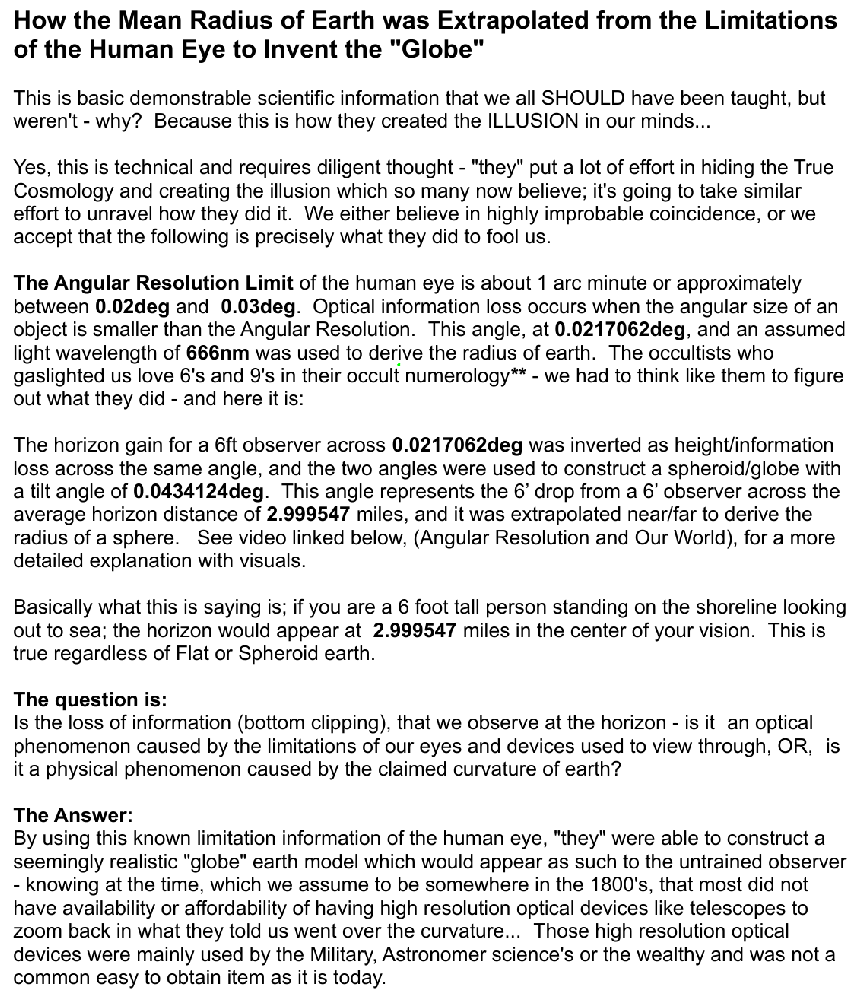



.png)
.png)
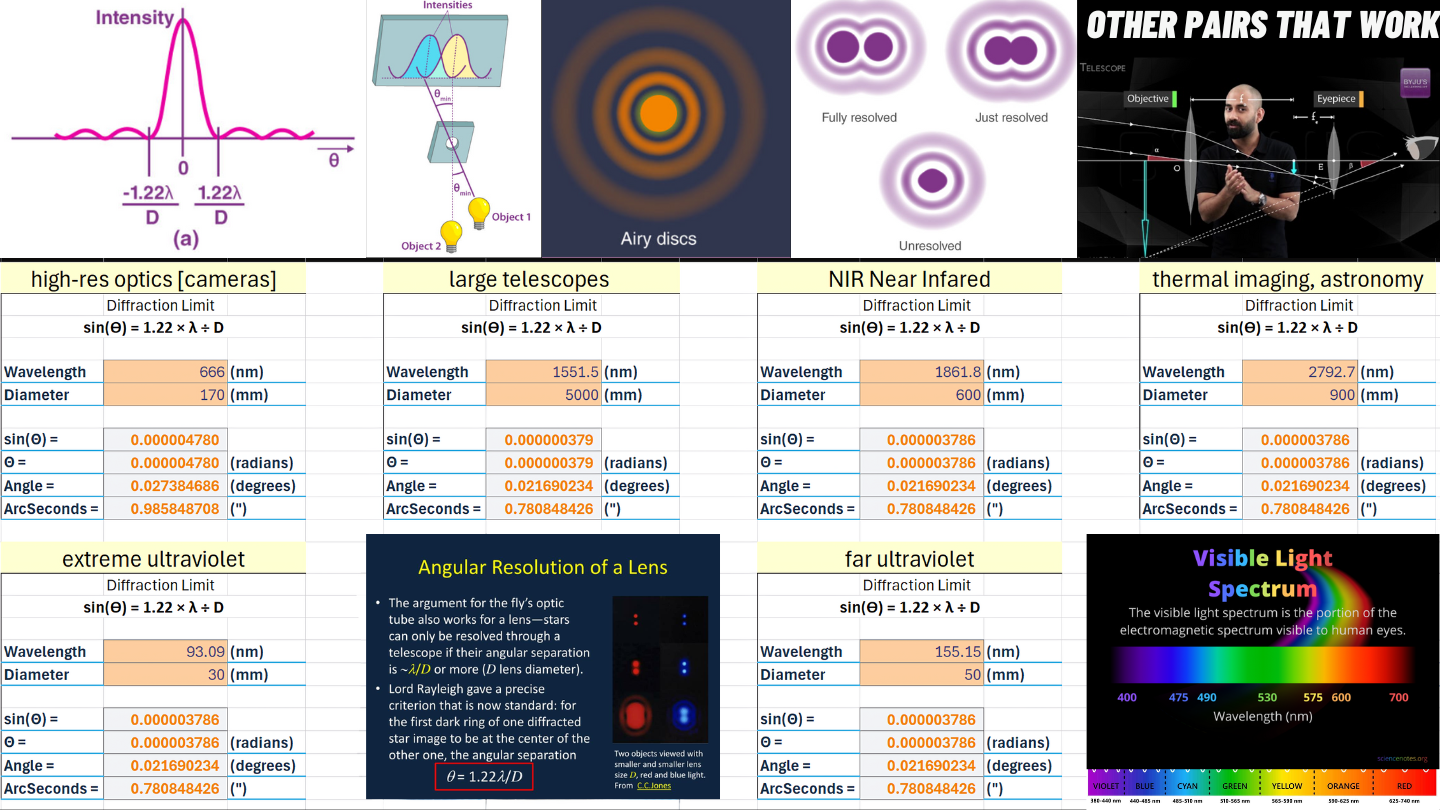
Ways to optically derive radius.
Computed by AI when given 2 of the 3 parameters:
---
Calculate the drop rate for the given drop over distance: For 12 feet over 3 miles, the drop rate is 8 inches per mile squared, or 8/12 feet per mile squared, which is approximately 0.666 feet per mile squared.
I determined the distance to the horizon for a 6-foot observer by using the formula ( d = 1.22 \sqrt{h} ), where ( d ) is the distance to the horizon in miles and ( h ) is the height of the observer in feet. Plugging in a height of 6 feet, we get:
( d = 1.22 \sqrt{6} )
( d = 1.22 \times 2.45 )
( d ≈ 3 ) miles
Therefore, the horizon for a 6-foot observer is approximately 3 miles away.
Using the angular resolution limit of 0.0316° (or 0.000552 radians) for the Raleigh criterion, we can calculate the radius value by equating the angular resolution to the tangent of the arc angle: Arc angle = 0.0316° = 0.000552 radians tan(0.000552) = R / 3 miles Solving for R, we get R ≈ 3959 miles.
---
To derive the radius value of 3959 miles based on the angular resolution limit of 0.0316° and the optic drop over a distance of 12 feet across 3 miles (using a drop rate of 8 inches per mile squared), we can calculate it as follows:
1. Calculate the drop rate for the given drop over distance: For 12 feet over 3 miles, the drop rate is 8 inches per mile squared, or 8/12 feet per mile squared, which is approximately 0.666 feet per mile squared.
2. Using the angular resolution limit of 0.0316° (or 0.000552 radians) for the Raleigh criterion, we can calculate the radius value by equating the angular resolution to the tangent of the arc angle: Arc angle = 0.0316° = 0.000552 radians tan(0.000552) = R / 3 miles
3. Solving for R, we get R ≈ 3959 miles.
Therefore, based on the given information and calculations, the derived radius value to meet the angular resolution limit of 0.0316° is approximately 3959 miles.
4. This can also be converted to a drop from 0 ft to -6 ft over 3 mi:
To derive the angular resolution limit based on the previously calculated radius of 3959 miles, we can use the formula that relates the radius of a circle to the arctangent function.
Given the radius as 3959 miles, we can calculate the angular resolution limit (θ) by solving the formula:
\tan(\theta) = \frac{R}{3miles}}
Plugging in the radius value of 3959 miles:
tan(\theta) = \frac{3959}{3}
\tan(\theta) ≈ 1319.67
By taking the arctangent of 1319.67 (in radians), we can determine the angular resolution limit corresponding to the previously derived radius of 3959 miles.
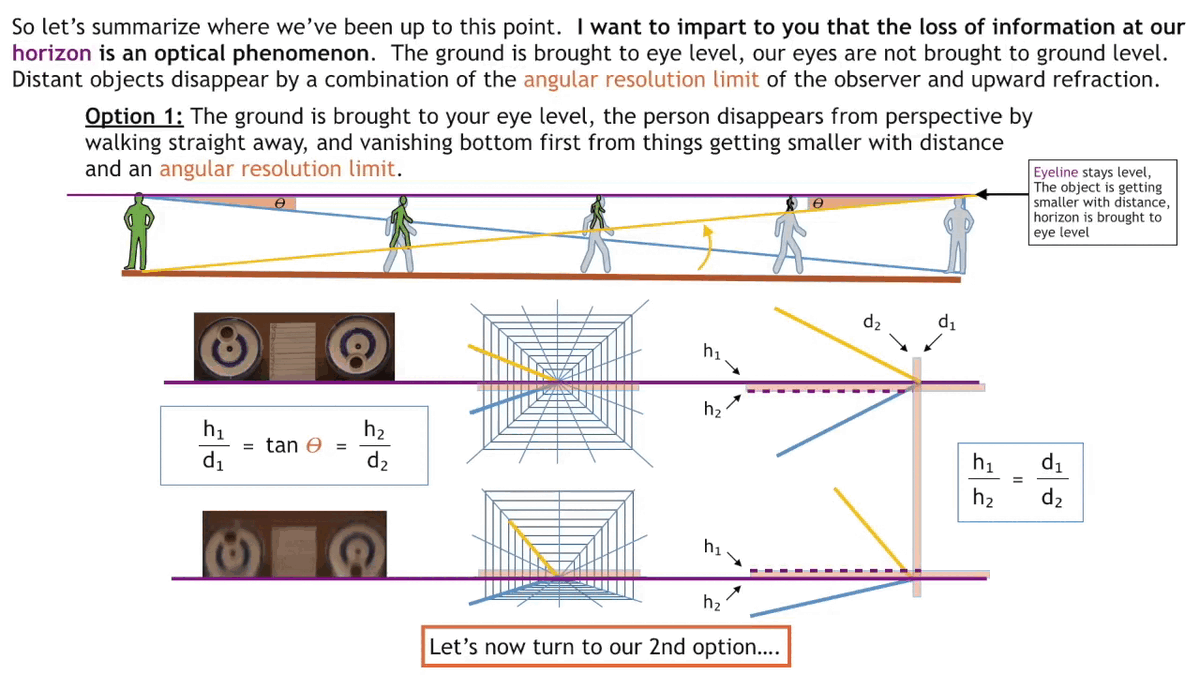
[Open: Pasted image 20240509192201.png](https://publish.obsidian.md/shanesql/Attachments/Pasted+image+20240509192201.jpeg)
[Open: Pasted image 20240509192201.jpeg](https://publish.obsidian.md/shanesql/Attachments/Pasted+image+20240509192201.jpeg)
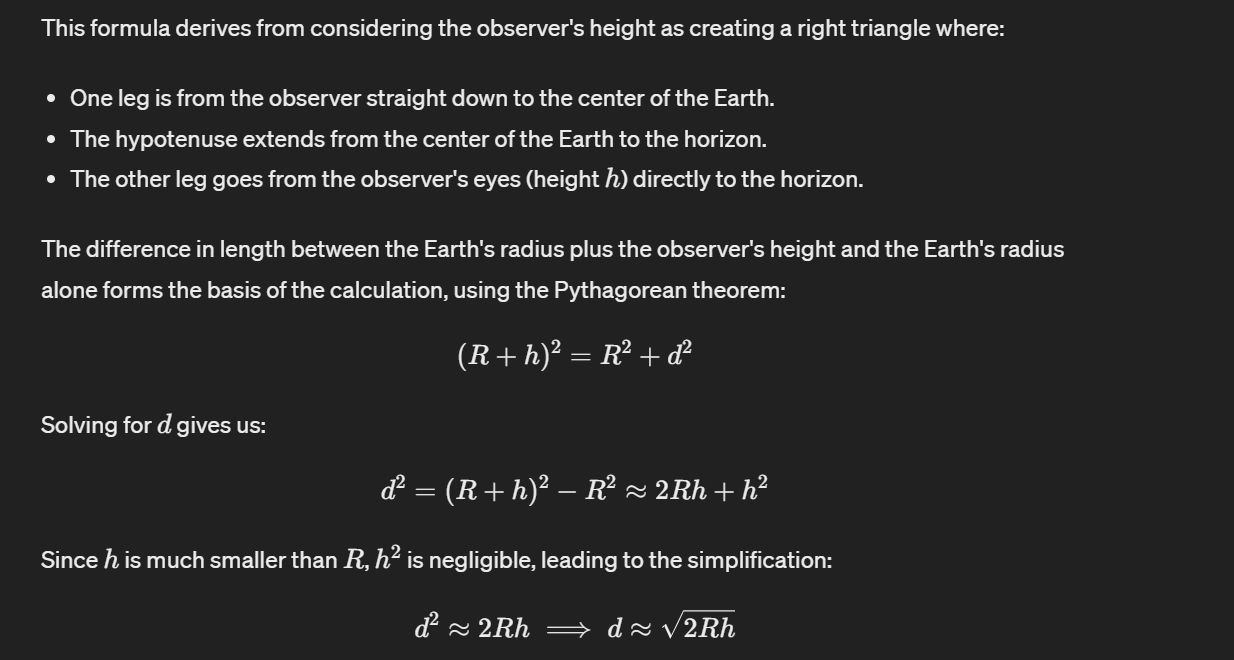
**Angular resolution calculated first:**
The angular resolution limit is a measure of the ability of an optical system, like the human eye, to distinguish between two separate points or objects that are close together. It is typically expressed in terms of the angle subtended by the smallest resolvable detail or feature.
To determine the angular resolution limit, you can use the formula:
[ \theta = \frac{\lambda}{D} ]
where:
- θ is the angular resolution limit,
- λ is the wavelength of light (often provided in nanometers),
- D is the diameter of the aperture (e.g., the pupil diameter of the eye).
By plugging in the appropriate values for λ and D, you can calculate the ang
Summary
- Earth's curvature is perceived through optical angles, horizon distances, angular resolution, and object descent rates in the field of vision.
- Proportional angle pairs diminish together based on the observer's position relative to the surrounding elements. Am example would be: The concept of a "ceiling/floor" or top/bottom limit that determines the horizon based on the nearest reference point, which impacts visual perception.
- The visual perception is influenced by the nearest ceiling or floor, setting the horizon, and the steeper descent rate affects the interpretation of depth in the field of vision. In this case and in almost all cases, the floor or lower limit becomes the horizon, dictating that objects disappear bottom up. The descending objects' height and distances create a relationship for the descent rate that creates a parabolic function which could be said to represent the rate at which the object recedes into the horizon.
- The angular resolution limit is closely approximated within the curved perspective
- The perceived rate of optical drop is 6 feet lost at 3 miles from a 6-foot observer height. Size changes are exponential within the observer's perspective.
- The observer perceives a 6-foot descent over 3 miles, with corresponding angle changes in observer height
This cannot be done without employing a limit of visual space in the shape of a curve.
That we have a limit of visual space described as a curve (the outward extending portion of a sphere), and to get this value we have to use an arc angle function
- The arc angle calculation from a 3-mile arc length or a 12-foot drop over 3 miles determines the Earth's radius to be approximately 3,978 miles
Putting it all together:
**The calculated height changes form a parabola, demonstrating the decreasing height with increasing distance as the person descends and moves away from the observer.
Putting it all together, the calculated height changes form a parabola, demonstrating the decreasing height with increasing distance as the person descends and moves away from the observer. Given that the observer is watching a person descend 3 miles east from their point of view, the following steps outline the calculation of the radius of the Earth optically, starting with the angular resolution limit:
1. We have an angular resolution of 0.0216° for the observer height from 6ft to 0ft and a second angular resolution of 0.0216° for the drop from 0ft to -6ft. These angles are represented as �=0.0216°H=0.0216° each.
2. The total angular change is calculated as 2�=0.0432°2H=0.0432°.
3. Using trigonometry, the tangent of the total angular change is calculated relative to the radius and the distance: tan(0.0432)=�3 milestan(0.0432)=3 milesR Solving for �R yields �≈3,978 milesR≈3,978 miles.
4. The drop distance of 12 ft over 3 miles is utilized to calculate the drop per mile as: 12 ft3 miles=0.002273 miles3 miles12 ft=0.002273 miles
5. This can also be converted to a drop from 0 ft to -6 ft over 3 miles: 6 ft3 miles=2 ft/mile3 miles6 ft=2 ft/mile
6. Converting this drop rate to a per-mile-squared rate results in: 0.666 ft12=0.0555 ft/mile2120.666 ft=0.0555 ft/mile2
7. The height changes based on distance can be calculated for various distances:
- When 1 mile: ℎ=1 ft/mile2h=1 ft/mile2
- When 2 miles: ℎ=4 ft/mile2h=4 ft/mile2
- When 3 miles: ℎ=9 ft/mile2h=9 ft/mile2
- When 4 miles: ℎ=16 ft/mile2h=16 ft/mile2
By following these outlined steps, the radius of the Earth can be derived optically, starting with the angular resolution limit and incorporating the provided visual perception factors and calculations.
The Formula: R(radius of earth) = d/(tan(2Theta))
published mean radius of earth:
The "globe earth's" officially stated radius is 6371km or 3958.8 mile
The Given: The following is how they derived it: Using a realistic human eye Angular Resolution limit of: 0.0217062 Thus making: 2Theta = (0.0217062 x 2) = 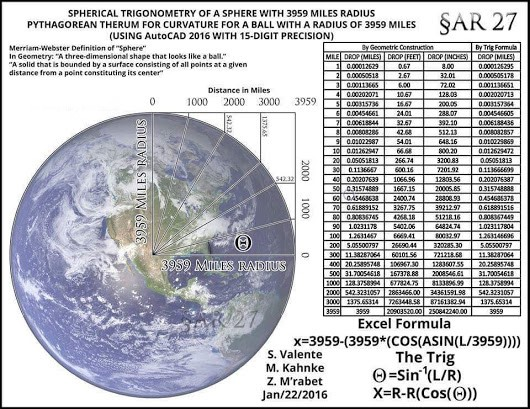
---
%202%201%201%201%201%201.jpg)
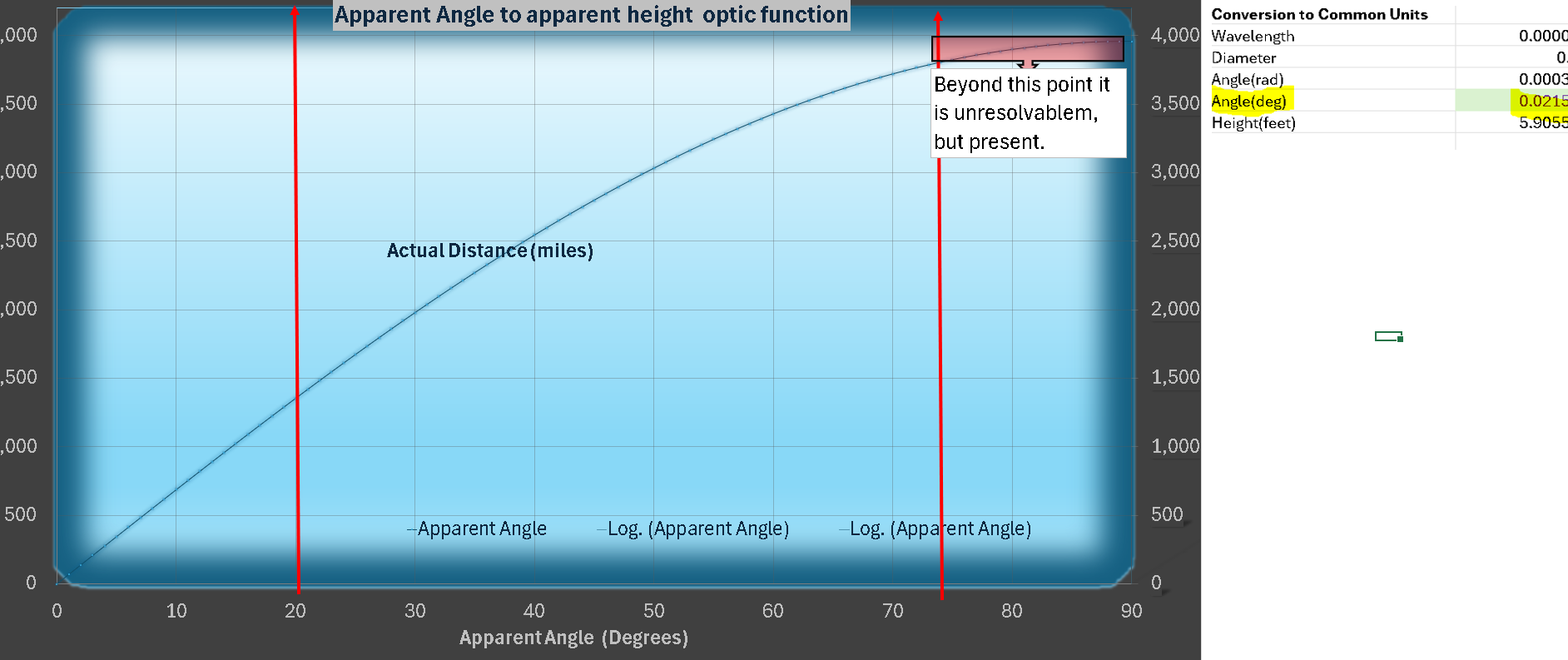
## Ways to Derive the other factors
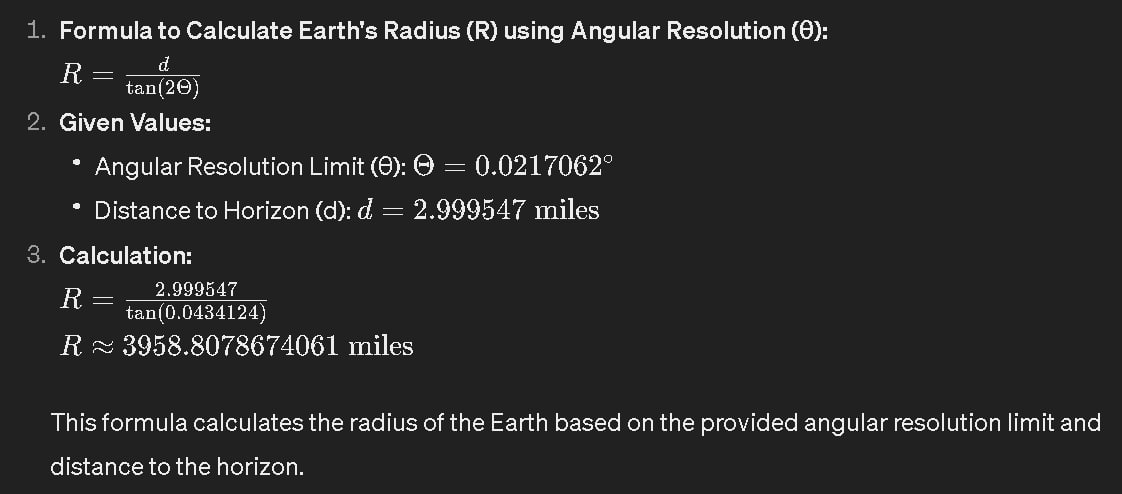
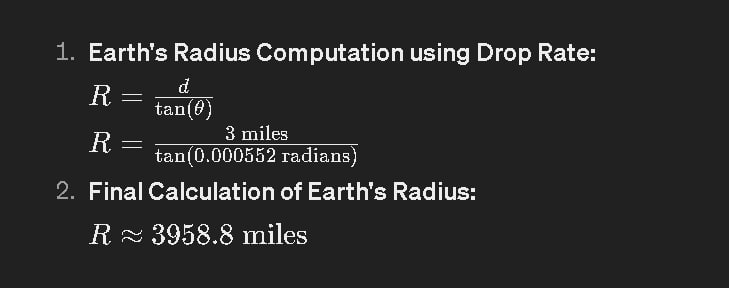



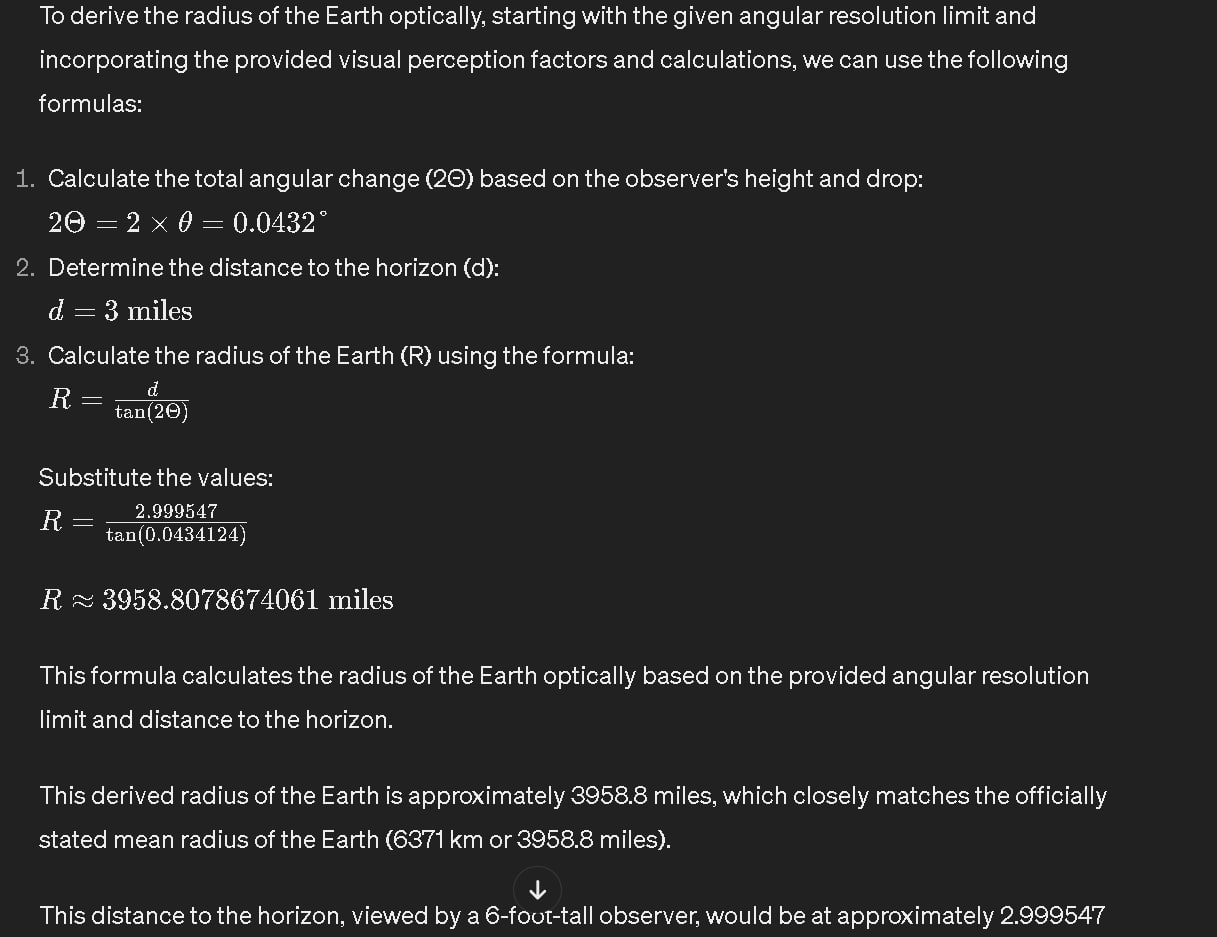
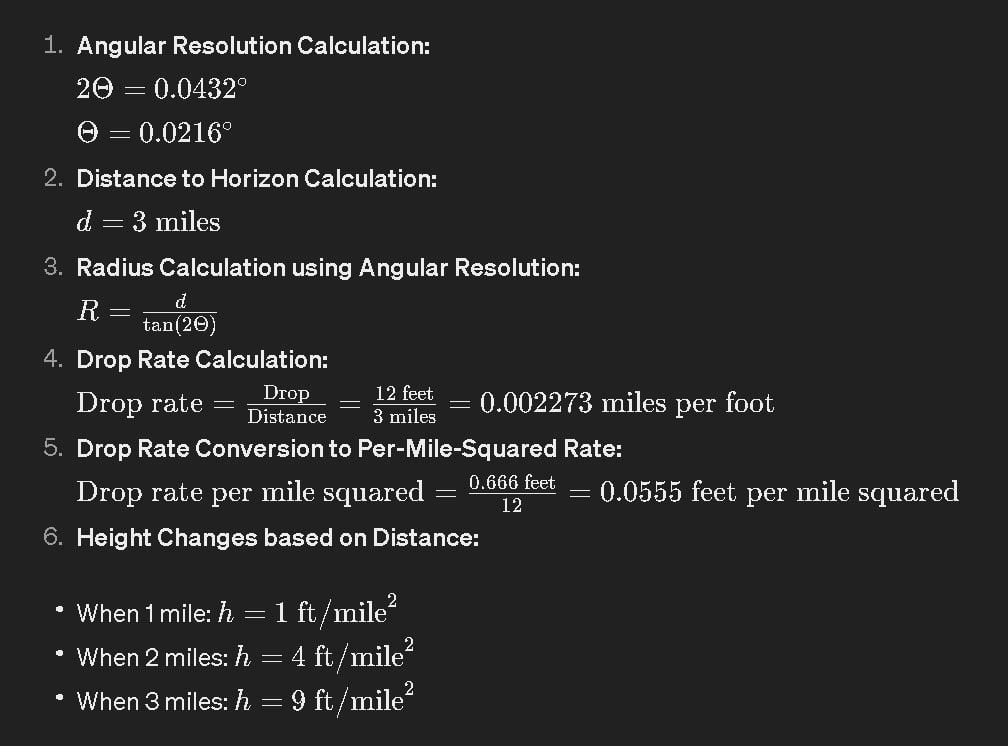
---
A brief explanation of why things disappear bottom up.
.gif)
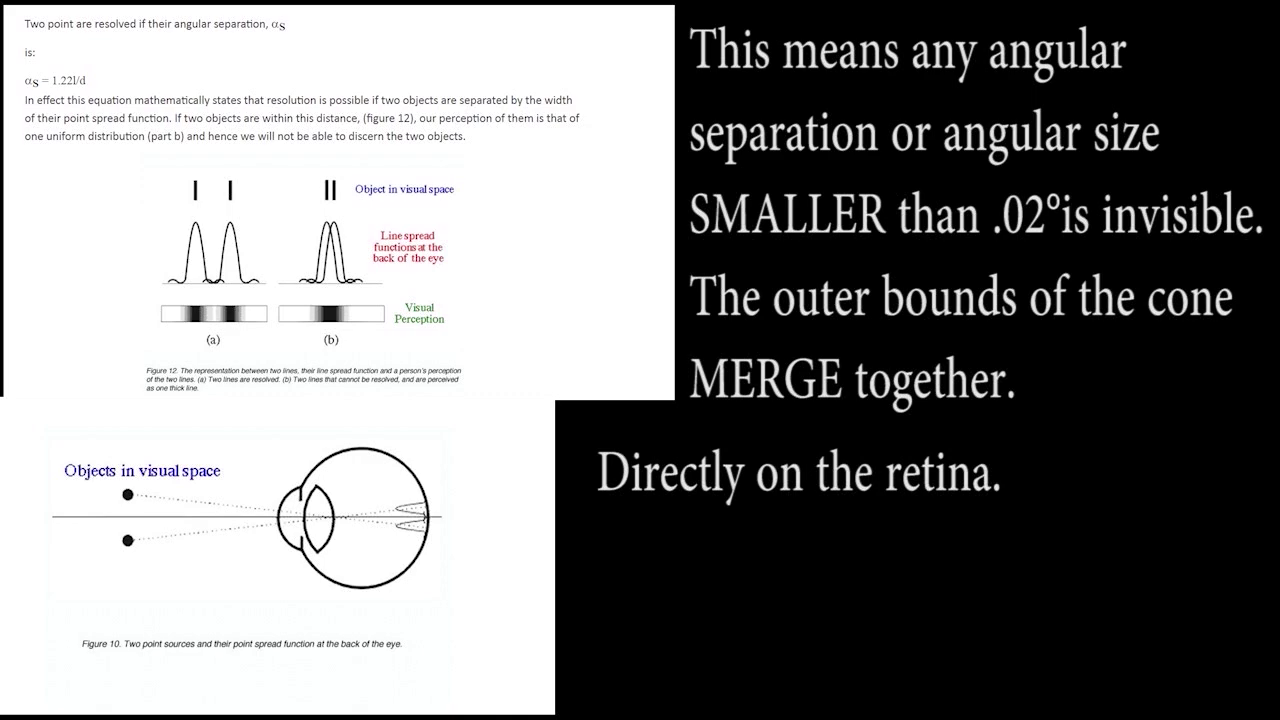
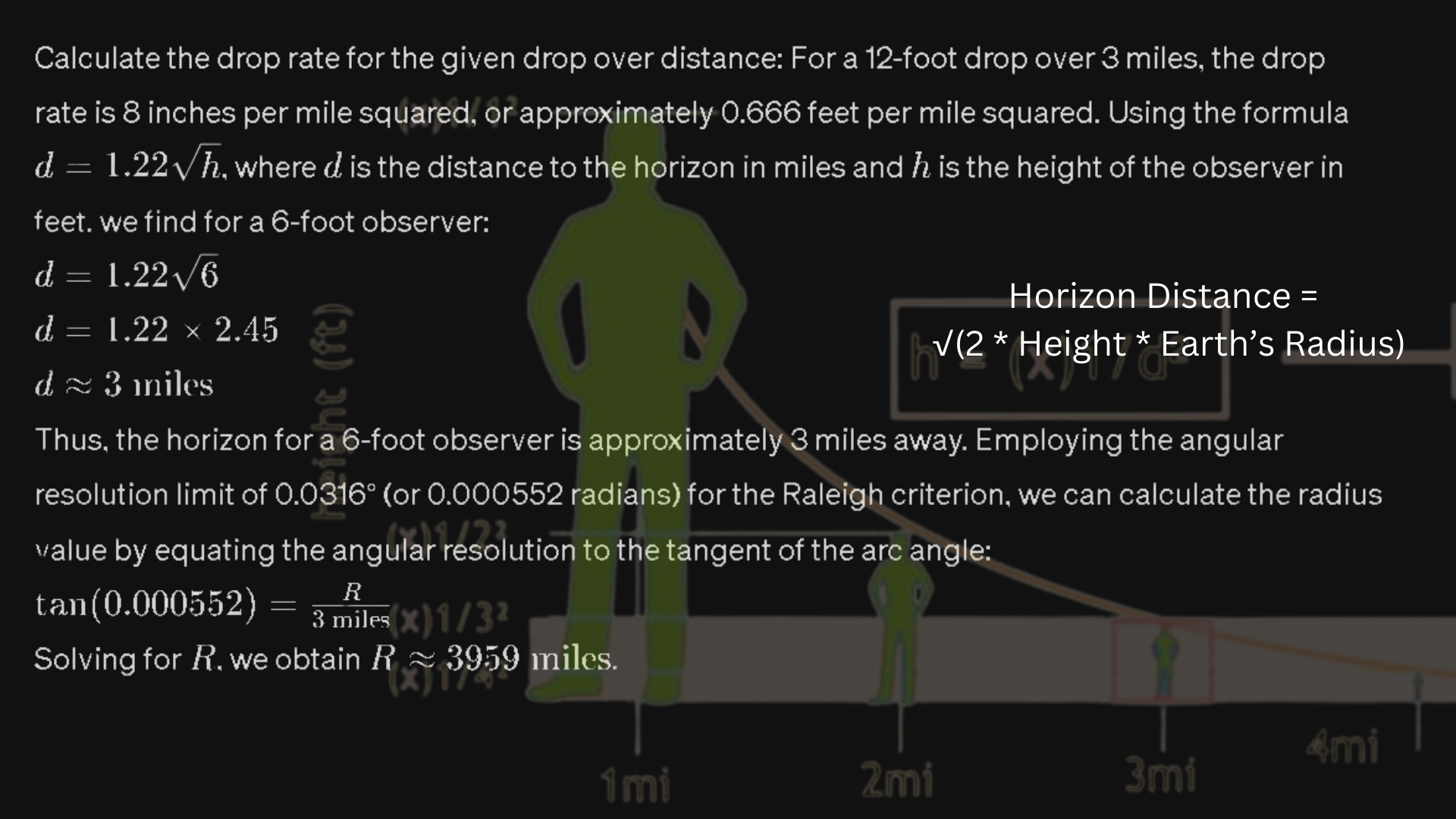
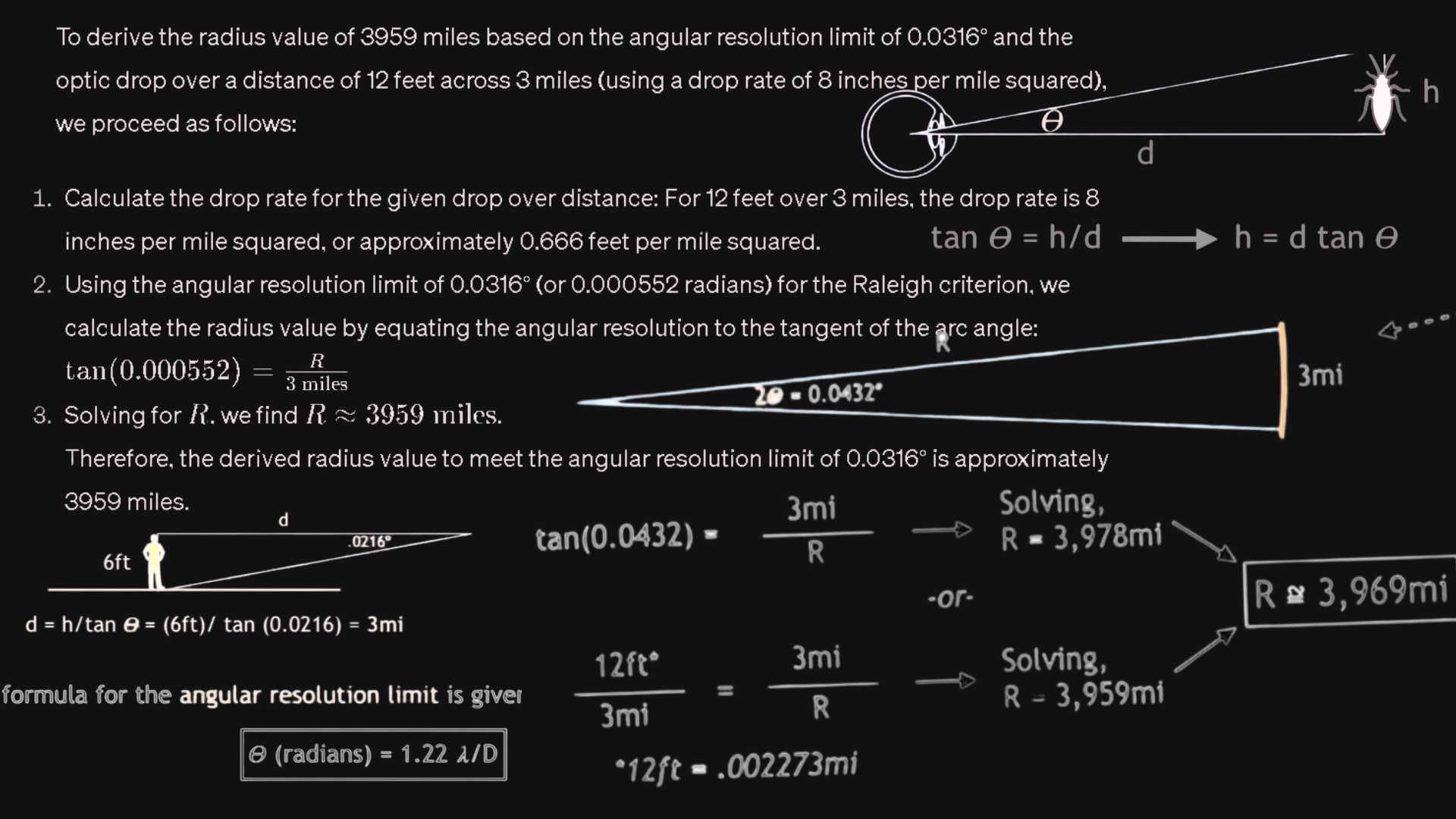
%201%201%201%201.png)
%201%201%201%201%201%201.png)
> %202%201%201%201%201%201.jpg)
### # Ways to Derive it






3 hours of STUNNING Visuals and excellent explanation on how our spherical vision handles perception.
---
Below is a mixture of images, text explanations and graphics intended to demonstrate how these two things become confused so frequently.
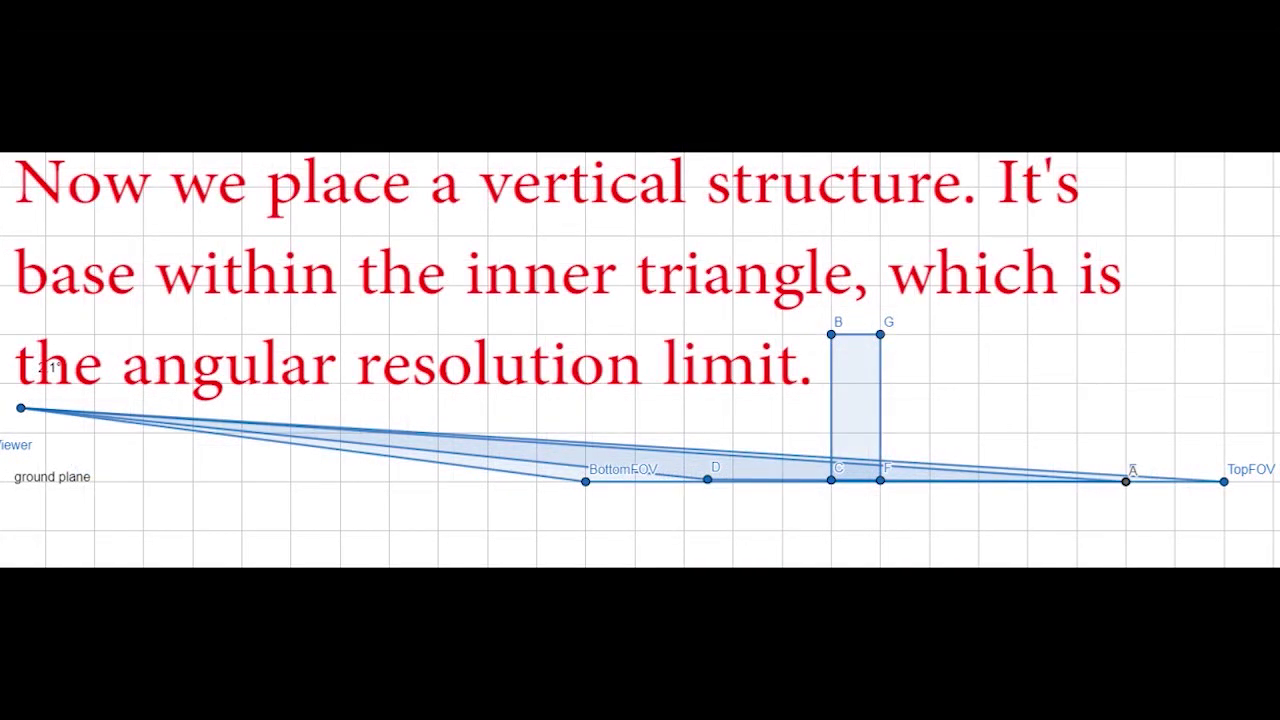

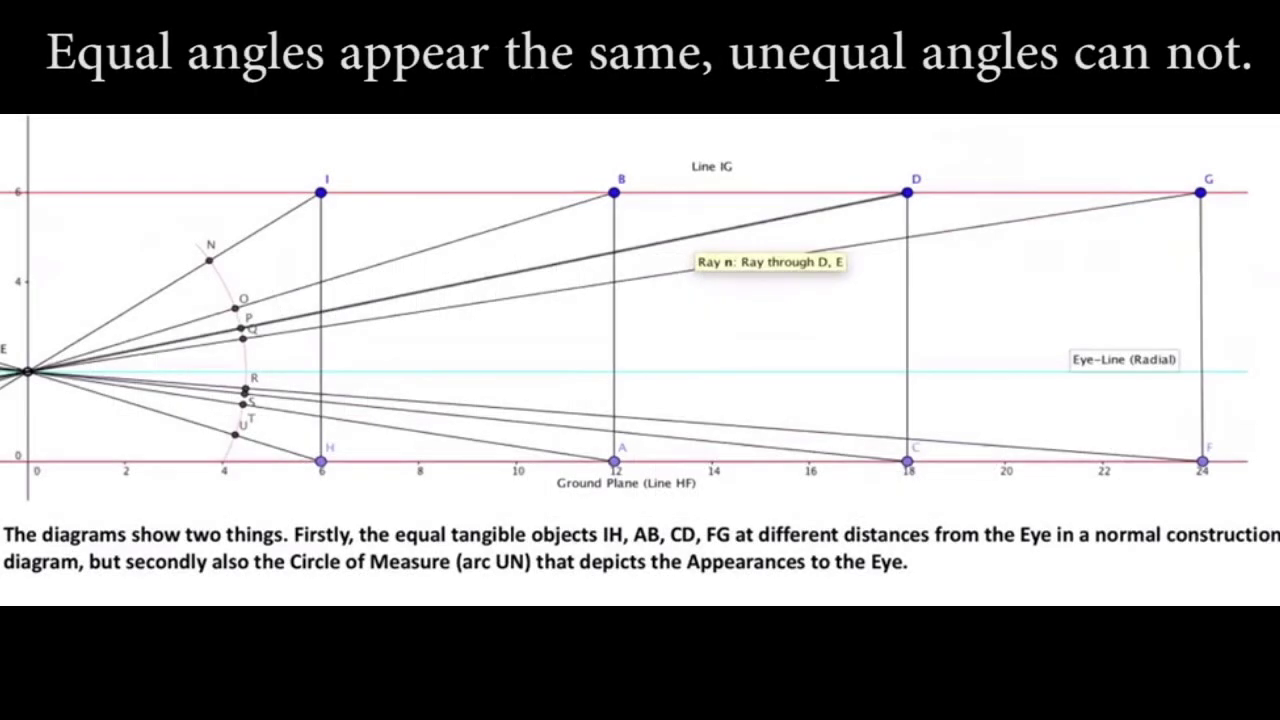
Gif of most of these in order:
Many more images and depictions below:
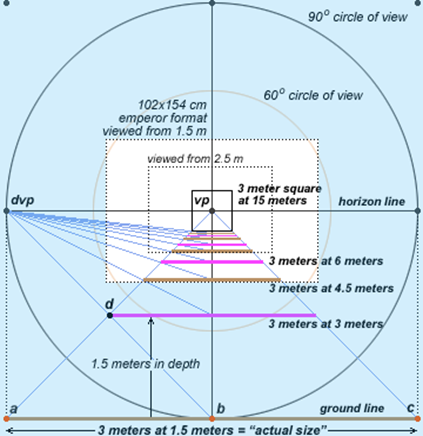

%201%201%201%201%201.png)
%201%201%201%201%201.png)


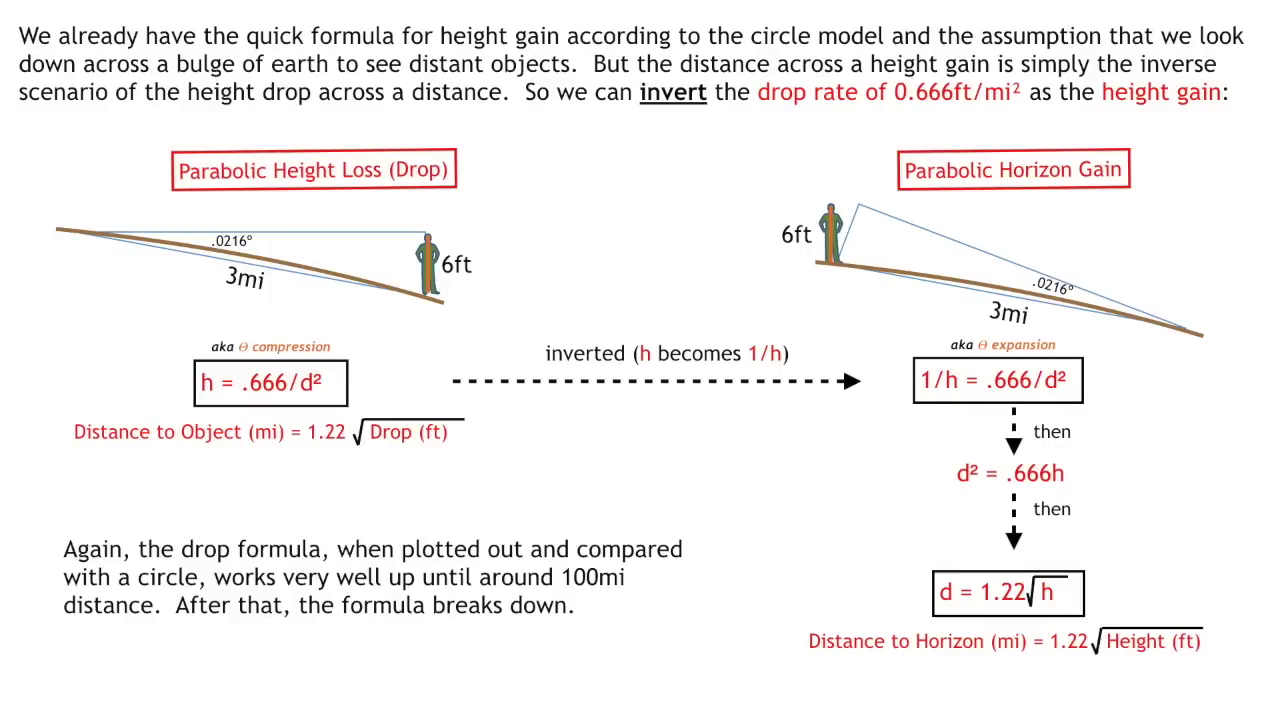
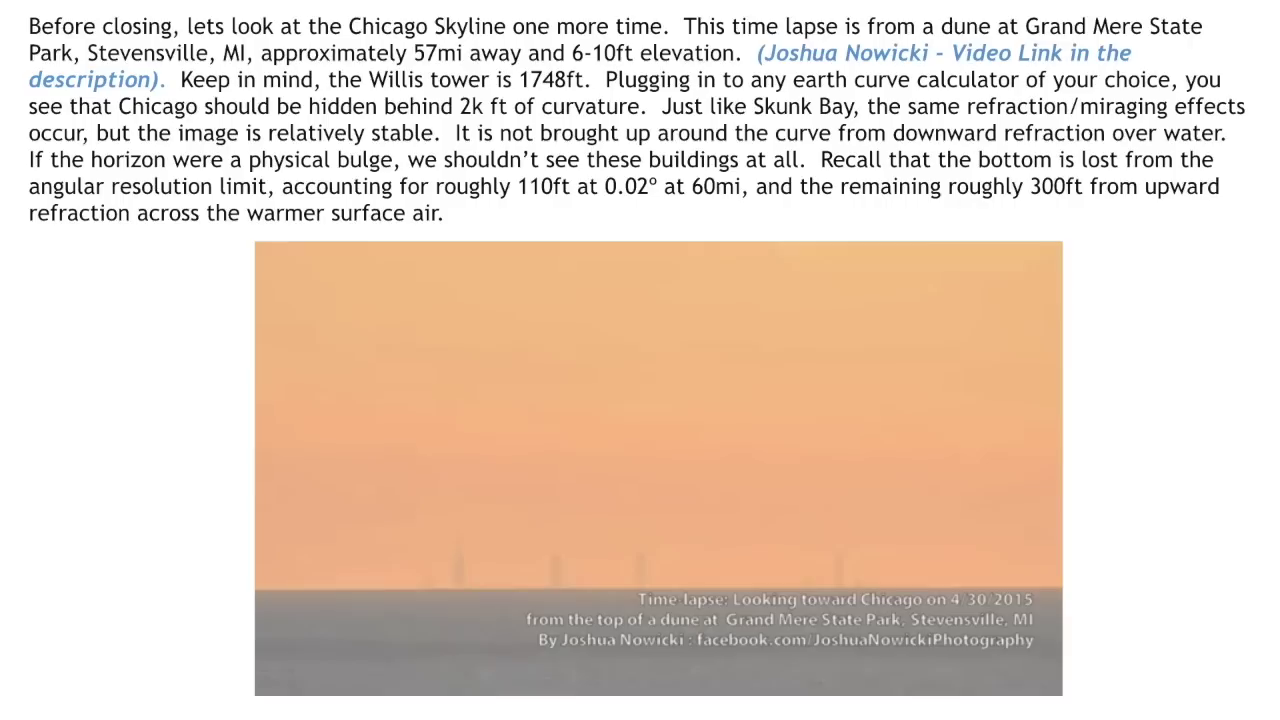
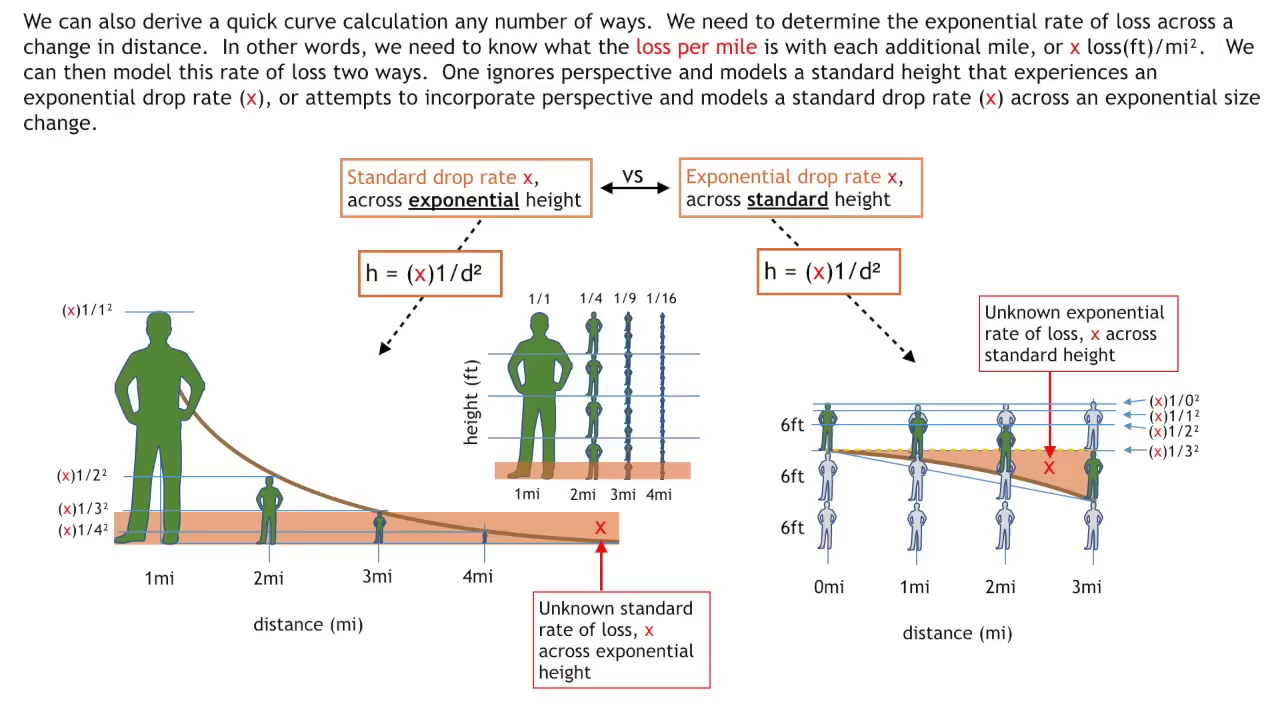



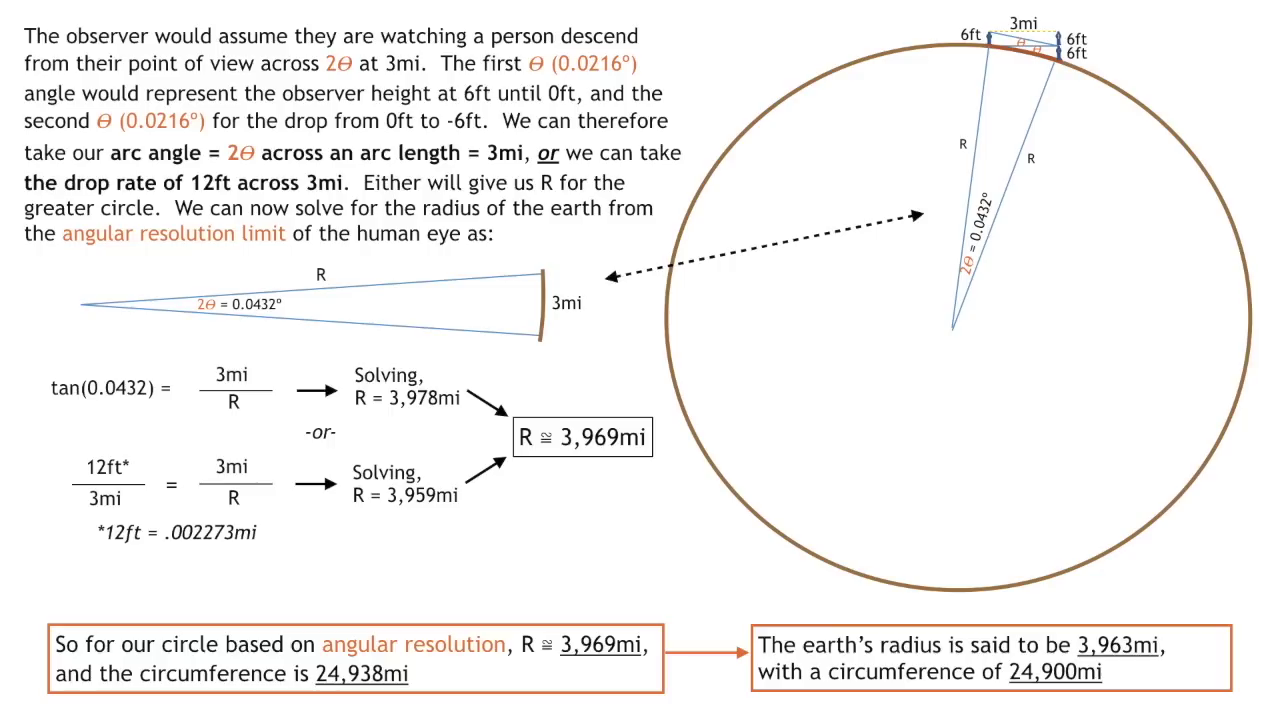

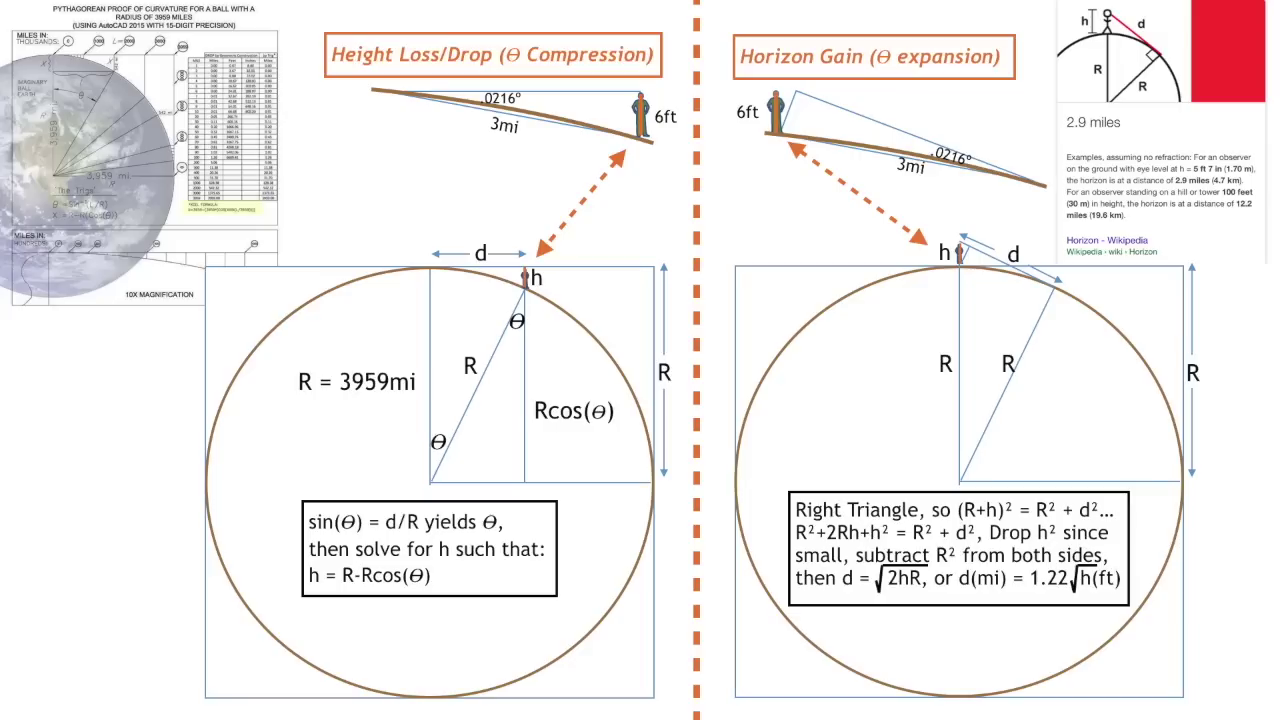
## Sources:
All images taken from this epic video:
# Angular Resolution and Our World
[https://www.youtube.com/watch?v=aVAWQGlXRWg&t=1530s&ab_channel=LifeIsShort](https://www.youtube.com/watch?v=aVAWQGlXRWg&t=1530s&ab_channel=LifeIsShort)
If starting to watch, would prefer you to watch the series parts 1-6:
[https://www.youtube.com/playlist?list=PLwl2JT--_2Wmp-mjOAjzA8zgeGtxI_r-V](https://www.youtube.com/playlist?list=PLwl2JT--_2Wmp-mjOAjzA8zgeGtxI_r-V))
### Angular Resolution, Diffraction Limit, and Horizon
For further exploration, check out this playlist: [Angular Resolution and Our World](https://www.youtube.com/playlist?list=PLwl2JT--_2Wmp-mjOAjzA8zgeGtxI_r-V). It expands on areas that may not have been made clear. God Bless.
1. **Vortex Puppy - Great Switcharoo**
- [THE GREAT SWITCHEROO](https://www.youtube.com/watch?v=OuEpiRe4C2s&list=WL&index=51&t=5243s)
2. **Phuket Word - Perspective**
- [Flat Earth Perspective Science For Du...](https://www.youtube.com/watch?v=jQwZuynnYHQ&list=WL&index=2&t=180s)
3. **Curious Life - Horizon**
- [Video](https://www.youtube.com/watch?v=9pXJZTaenOA&list=WL&index=25&t=0s)
4. **Nathan Oakley/Jose JG Gonzalez - Supermarket Light Set**
- [Angle Of Attack By Jose JG Gonzalez](https://www.youtube.com/watch?v=eg9FKRz05Js&list=WL&index=2&t=0s)
5. **P-Brane - How the sky works**
- [Anti Crepuscular Sun Rays are KEY to...](https://www.youtube.com/watch?v=t30-YbayyXE&list=WL&index=43&t=986s)
6. **Wide Awake - Boats coming into view**
- [Flat Earth Edge of Perception & the v...](https://www.youtube.com/watch?v=p_KaGQR9viE&list=WL&index=34&t=0s)
7. **Taboo Conspiracy - SkunkBay timelapse mirror**
- [Video](https://www.youtube.com/watch?v=QQN2o8EUZtI&list=WL&index=32&t=0s)
8. **Bmlsb69 - Oil Rigs and Horizon**
- [Ocean Horizon Rising (atmosphere) Blo...](https://www.youtube.com/watch?v=OgA_7-bHvyo&list=WL&index=29&t=0s)
9. **Dr. John D - Brighton Sea Front**
- [Viewing Brighton Seafront from Worthi...](https://www.youtube.com/watch?v=jfkm3wsRFL8&list=WL&index=4&t=0s)
10. **Joshua Nowicki - Chicago Skyline Timelapse**
- [Time-lapse: Looking toward Chicago fr...](https://www.youtube.com/watch?v=FTFEu-Tod7s&list=WL&index=9&t=0s)
- [Video](https://www.youtube.com/watch?v=3St1vXoiSzY&list=WL&index=8&t=0s)
- [Time-lapse: Looking toward Chicago fr...](https://www.youtube.com/watch?v=-_du4A37Pjo&list=WL&index=6&t=0s)
11. **Stationary Earth Experiments**
- [Video](https://www.youtube.com/watch?v=Xg96dC6ylTI&list=WL&index=53&t=0s)
12. **Gudtims4all - Angular Resolution Lids**
- [- one reason buildings disappear - di...](https://www.youtube.com/watch?v=PtRXf92_W2o&list=WL&index=11&t=0s)
- [- lid diffraction experiment III -](https://www.youtube.com/watch?v=_k8xgXodHAk&list=WL&index=10&t=0s)
13. **JTolan Media 1 - Infrared Photography** (Link not provided but you can search for "JTolan Media 1" on YouTube for infrared photography-related content).
Rar file with 120 visuals
# Key Points
(Summarized by AI)
Key Points
1. The research paper explores how observer height and perspective impact object perception, discussing the compression and expansion of angles, as well as the convergence of light rays by the eye affecting distance and size perception.
2. It delves into the angular resolution limit, diffraction, and refraction of light, explaining how these phenomena relate to the human eye's image resolution, magnification, and the perception of celestial objects and natural light phenomena over water.
3. The paper challenges the traditional scientific understanding of Earth's curvature and shape, suggesting the Earth is not a sphere but rather flat and closed, drawing from scientific, biblical, esoteric, and religious evidence to call for a reexamination of existing beliefs about the Earth's cosmology.
Observer Height and Perspective in Object Perception
The research paper explores the impact of observer height and [perspective](https://en.wikipedia.org/?curid=2900846) on the perception of objects and the horizon. It discusses how the [compression](https://en.wikipedia.org/?curid=38808) and [expansion](https://en.wikipedia.org/?curid=988163) of [angles](https://en.wikipedia.org/?curid=1272177) due to the observer's height directly affect the perceived size and position of objects and the horizon line. The paper provides illustrations and examples to demonstrate how objects move and change in relation to the observer's eye line. It also explains how the [convergence](https://en.wikipedia.org/?curid=349779) of light rays by the eye affects the perception of distance and size of objects. In conclusion, the paper highlights the direct proportional relationship between the observer's height and the position of the lower horizon line, and how it impacts the perception of distant objects and the horizon. [ 1224 ]
**Angular Resolution Limit and Light Phenomena**
The research paper discussed the angular resolution limit, [diffraction](https://en.wikipedia.org/?curid=8603), and [refraction](https://en.wikipedia.org/?curid=25948) of light. The paper explored how the human eye resolves images and the [diffraction](https://en.wikipedia.org/?curid=8603) limit, which is influenced by the wavelength of light and the diameter of the aperture. The formula for angular resolution limit and its application in calculating the smallest resolution angle for the human eye was detailed. The effect of [magnification](https://en.wikipedia.org/?curid=603273) on [perspective](https://en.wikipedia.org/?curid=2900846) and the use of angular resolution to calculate the size and distance of celestial objects such as the moon and the sun were also discussed. Additionally, the paper addressed the inferior mirage, [refraction](https://en.wikipedia.org/?curid=25948) effects over water, and the [refraction](https://en.wikipedia.org/?curid=25948) of laser light over large bodies of water. It also mentioned the stability of [diffraction](https://en.wikipedia.org/?curid=8603) compared to the variability of [refraction](https://en.wikipedia.org/?curid=25948) in atmospheric conditions. [ 1736 ]
The research paper discusses the visual phenomenon of the Chicago skyline being visible from a distance of 60 miles, challenging the traditional understanding of Earth's curvature. The author uses various footage and observations to argue that the buildings should be hidden due to the Earth's curvature, but they are visible due to a combination of [diffraction](https://en.wikipedia.org/?curid=8603) limit and warm air over Lake Michigan. The paper also delves into historical astronomical experiments and calculations to suggest that the Earth is stationary and that the assumption of Earth's rotation is flawed. [ 42 ]
## Spherical Limit of Vision
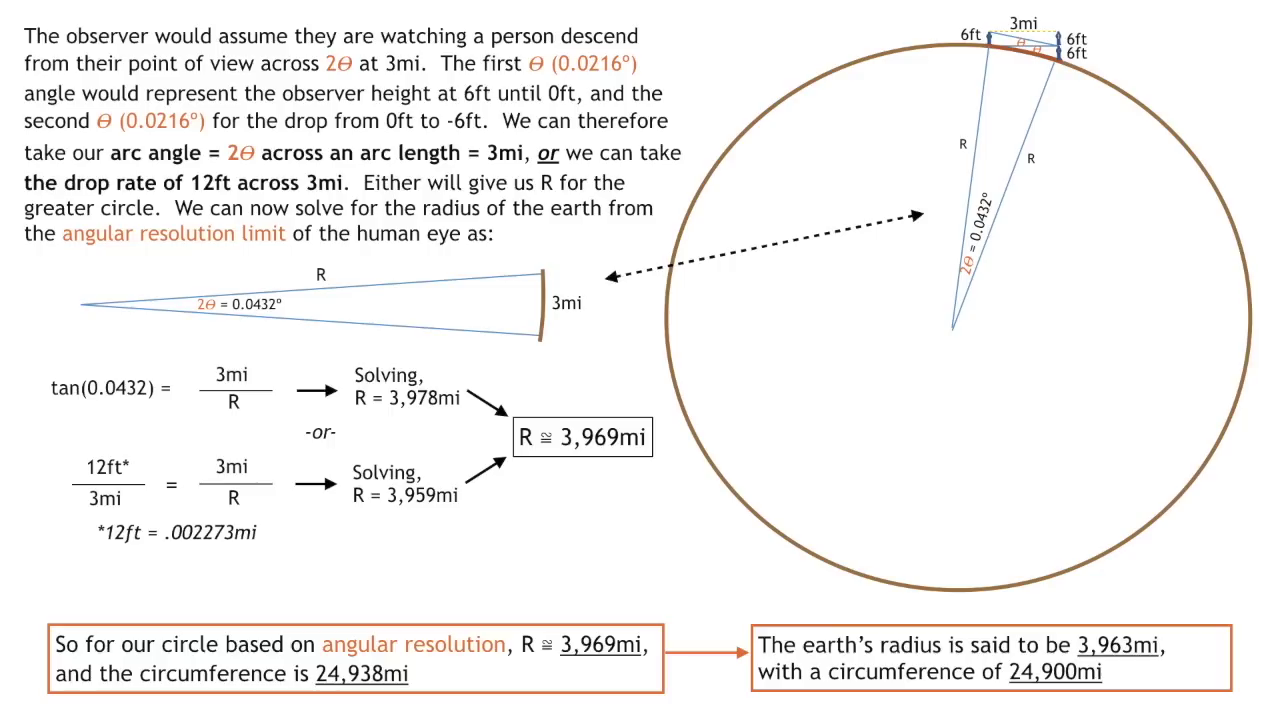
[Open: Pasted image 20240509185900.png](https://publish.obsidian.md/shanesql/Attachments/Pasted+image+20240509185900.png)
Many more images and depictions below:
curvature is 6 feet lost at 3 miles from a 6-foot observer height.
The angular resolution limit is approximated closely within the curved perspective.
Two crossover points exist at 0 miles and 3 miles, and the size change is exponential within the observer's perspective.
The observer views a person descending 6 feet over 3 miles, with angles representing changes in observer height from 6 feet to 0 feet and then to -6 feet.
The arc angle is calculated from an arc length of 3 miles or a drop distance of 12 feet over 3 miles to determine the radius of the Earth.
Using the angular resolution limit, the radius is calculated to be approximately 3,978 miles.
The drop rate for exponential size changes is approximated, resulting in a parabolic height adjustment with increasing distance.
[https://share.descript.com/view/zMMDsqIZtB1](https://share.descript.com/view/zMMDsqIZtB1)
Ways to optically derive radius.
Computed by AI when given 2 of the 3 parameters:
---
Calculate the drop rate for the given drop over distance: For 12 feet over 3 miles, the drop rate is 8 inches per mile squared, or 8/12 feet per mile squared, which is approximately 0.666 feet per mile squared.
I determined the distance to the horizon for a 6-foot observer by using the formula ( d = 1.22 \sqrt{h} ), where ( d ) is the distance to the horizon in miles and ( h ) is the height of the observer in feet. Plugging in a height of 6 feet, we get:
( d = 1.22 \sqrt{6} )
( d = 1.22 \times 2.45 )
( d ≈ 3 ) miles
Therefore, the horizon for a 6-foot observer is approximately 3 miles away.
Using the angular resolution limit of 0.0316° (or 0.000552 radians) for the Raleigh criterion, we can calculate the radius value by equating the angular resolution to the tangent of the arc angle: Arc angle = 0.0316° = 0.000552 radians tan(0.000552) = R / 3 miles Solving for R, we get R ≈ 3959 miles.
---
To derive the radius value of 3959 miles based on the angular resolution limit of 0.0316° and the optic drop over a distance of 12 feet across 3 miles (using a drop rate of 8 inches per mile squared), we can calculate it as follows:
1. Calculate the drop rate for the given drop over distance: For 12 feet over 3 miles, the drop rate is 8 inches per mile squared, or 8/12 feet per mile squared, which is approximately 0.666 feet per mile squared.
2. Using the angular resolution limit of 0.0316° (or 0.000552 radians) for the Raleigh criterion, we can calculate the radius value by equating the angular resolution to the tangent of the arc angle: Arc angle = 0.0316° = 0.000552 radians tan(0.000552) = R / 3 miles
3. Solving for R, we get R ≈ 3959 miles.
Therefore, based on the given information and calculations, the derived radius value to meet the angular resolution limit of 0.0316° is approximately 3959 miles.
4. This can also be converted to a drop from 0 ft to -6 ft over 3 mi:
To derive the angular resolution limit based on the previously calculated radius of 3959 miles, we can use the formula that relates the radius of a circle to the arctangent function.
Given the radius as 3959 miles, we can calculate the angular resolution limit (θ) by solving the formula:
\tan(\theta) = \frac{R}{3miles}}
Plugging in the radius value of 3959 miles:
tan(\theta) = \frac{3959}{3}
\tan(\theta) ≈ 1319.67
By taking the arctangent of 1319.67 (in radians), we can determine the angular resolution limit corresponding to the previously derived radius of 3959 miles.
**Angular resolution calculated first:**
The angular resolution limit is a measure of the ability of an optical system, like the human eye, to distinguish between two separate points or objects that are close together. It is typically expressed in terms of the angle subtended by the smallest resolvable detail or feature.
To determine the angular resolution limit, you can use the formula:
[ \theta = \frac{\lambda}{D} ]
where:
- θ is the angular resolution limit,
- λ is the wavelength of light (often provided in nanometers),
- D is the diameter of the aperture (e.g., the pupil diameter of the eye).
By plugging in the appropriate values for λ and D, you can calculate the angular resolution limit for the given optical system.
Summary
- Earth's curvature is perceived through optical angles, horizon distances, angular resolution, and object descent rates in the field of vision.
- Proportional angle pairs diminish together based on the observer's position relative to the surrounding elements. Am example would be: The concept of a "ceiling/floor" or top/bottom limit that determines the horizon based on the nearest reference point, which impacts visual perception.
- The visual perception is influenced by the nearest ceiling or floor, setting the horizon, and the steeper descent rate affects the interpretation of depth in the field of vision. In this case and in almost all cases, the floor or lower limit becomes the horizon, dictating that objects disappear bottom up. The descending objects' height and distances create a relationship for the descent rate that creates a parabolic function which could be said to represent the rate at which the object recedes into the horizon.
- The angular resolution limit is closely approximated within the curved perspective
- The perceived rate of optical drop is 6 feet lost at 3 miles from a 6-foot observer height. Size changes are exponential within the observer's perspective.
- The observer perceives a 6-foot descent over 3 miles, with corresponding angle changes in observer height
This cannot be done without employing a limit of visual space in the shape of a curve.
That we have a limit of visual space described as a curve (the outward extending portion of a sphere), and to get this value we have to use an arc angle function
- The arc angle calculation from a 3-mile arc length or a 12-foot drop over 3 miles determines the Earth's radius to be approximately 3,978 miles
Putting it all together:
**The calculated height changes form a parabola, demonstrating the decreasing height with increasing distance as the person descends and moves away from the observer.
Putting it all together, the calculated height changes form a parabola, demonstrating the decreasing height with increasing distance as the person descends and moves away from the observer. Given that the observer is watching a person descend 3 miles east from their point of view, the following steps outline the calculation of the radius of the Earth optically, starting with the angular resolution limit:
```
- When 4 miles: ℎ=16 ft/mile2h=16 ft/mile2
```
# Drop Rate
Objects disappear from the bottom up due to the curvature, influenced by the observer's height, the distance to the object, and the angular resolution limit.
The rate at which objects descend in the field of vision is determined by the drop rate and the observer's distance to the horizon.
Drop Rate: Drop per mile^2 = 2/3 feet.
Horizon Distance: Distance = 1.22 × sqrt(6) miles.
Radius Calculation: R = distance × tan(0.000552).
Angular Resolution: θ = arctan(R / distance).
1. We have an angular resolution of 0.0216° for the observer height from 6ft to 0ft and a second angular resolution of 0.0216° for the drop from 0ft to -6ft. These angles are represented as �=0.0216°H=0.0216° each.
2. The total angular change is calculated as 2�=0.0432°2H=0.0432°.
3. Using trigonometry, the tangent of the total angular change is calculated relative to the radius and the distance: tan(0.0432)=�3 milestan(0.0432)=3 milesR Solving for �R yields �≈3,978 milesR≈3,978 miles.
4. The drop distance of 12 ft over 3 miles is utilized to calculate the drop per mile as: 12 ft3 miles=0.002273 miles3 miles12 ft=0.002273 miles
5. This can also be converted to a drop from 0 ft to -6 ft over 3 miles: 6 ft3 miles=2 ft/mile3 miles6 ft=2 ft/mile
6. Converting this drop rate to a per-mile-squared rate results in: 0.666 ft12=0.0555 ft/mile2120.666 ft=0.0555 ft/mile2
7. The height changes based on distance can be calculated for various distances:
- When 1 mile: ℎ=1 ft/mile2h=1 ft/mile2
- When 2 miles: ℎ=4 ft/mile2h=4 ft/mile2
- When 3 miles: ℎ=9 ft/mile2h=9 ft/mile2
By following these outlined steps, the radius of the Earth can be derived optically, starting with the angular resolution limit and incorporating the provided visual perception factors and calculations.
The Formula: R(radius of earth) = d/(tan(2Theta))
published mean radius of earth:
The "globe earth's" officially stated radius is 6371km or 3958.8 mile
The Given: The following is how they derived it: Using a realistic human eye Angular Resolution limit of: 0.0217062 Thus making: 2Theta = (0.0217062 x 2) =
0.0434124 d = Distance to Horizon = 2.999547 miles
The Math:
R = 2.999547/(tan(0.0434124))R = 3958.8078674061 miles
Given: A drop of 12 feet over 3 miles.
Drop Rate Formula: Drop per mile squared = Drop (in feet) / Distance^2 (in miles).
Calculation: 8 inches per mile squared or 2/3 feet per mile squared, approximately equals 0.666 feet per mile squared.
Using Rayleigh Criterion: Angular resolution θ = 0.0316° or 0.000552 radians.
Formula: tan(θ) = R / distance.
Given Distance: 3 miles.
Solving for R: R ≈ 3959 miles when θ = 0.000552 radians.
Formula: θ = arctan(R / distance).
Given: R = 3959 miles.
Calculation: θ = arctan(3959 / 3), resulting in the angular resolution corresponding to the radius of 3959 miles.
Objects disappear from the bottom up due to the curvature, influenced by the observer's height, the distance to the object, and the angular resolution limit.
The rate at which objects descend in the field of vision is determined by the drop rate and the observer's distance to the horizon.
Drop Rate: Drop per mile^2 = 2/3 feet.
Horizon Distance: Distance = 1.22 × sqrt(6) miles.
Radius Calculation: R = distance × tan(0.000552).
Angular Resolution: θ = arctan(R / distance).
Formula:
- Distance to horizon = 1.22 × sqrt(height).
Given:
- Height = 6 feet.
Calculation:
- Distance ≈ 1.22 × sqrt(6) ≈ 3 miles.
Using Rayleigh Criterion:
- Angular resolution, θ = 0.0316° or 0.000552 radians.
Formula:
- tan(θ) = R / distance.
Given:
- Distance = 3 miles.
Calculation:
- R ≈ 3959 miles for θ = 0.000552 radians.
Using Rayleigh Criterion:
- Angular resolution, θ = 0.0316° or 0.000552 radians.
Formula:
- tan(θ) = R / distance.
Given:
- Distance = 3 miles.
Calculation:
- R ≈ 3959 miles for θ = 0.000552 radians.
Formula:
- θ = arctan(R / distance).
Given:
- R = 3959 miles.
Calculation:
- θ = arctan(3959 / 3).
Conceptual:
- Objects disappear from the bottom up influenced by observer's height, distance to the object, and angular resolution limit.
Influencing Factors:
- Drop rate and observer's distance to horizon.
- Drop Rate: Drop per mile^2 = (2/3) feet.
- Horizon Distance: Distance = 1.22 × sqrt(6) miles.
- Radius Calculation: R = distance × tan(0.000552).
- Angular Resolution: θ = arctan(R / distance).
The distance to the horizon viewed by 6 foot tall person(P1) would be at 2.999547 miles - meaning that if another 6 foot tall person(P2) was 2.999547 miles in the distance, the top of P2's head would be just barely hidden behind the horizon from the viewpoint of P1. The reality is that there is no curvature hiding P2; it's only that at 2.999547 miles that P1's Angular Resolution limit has been reached concerning an object the size of another 6 foot tall person
|R(radius of earth) = d/(tan(2Theta)|
R (radius of Earth)=tan(2Θ)d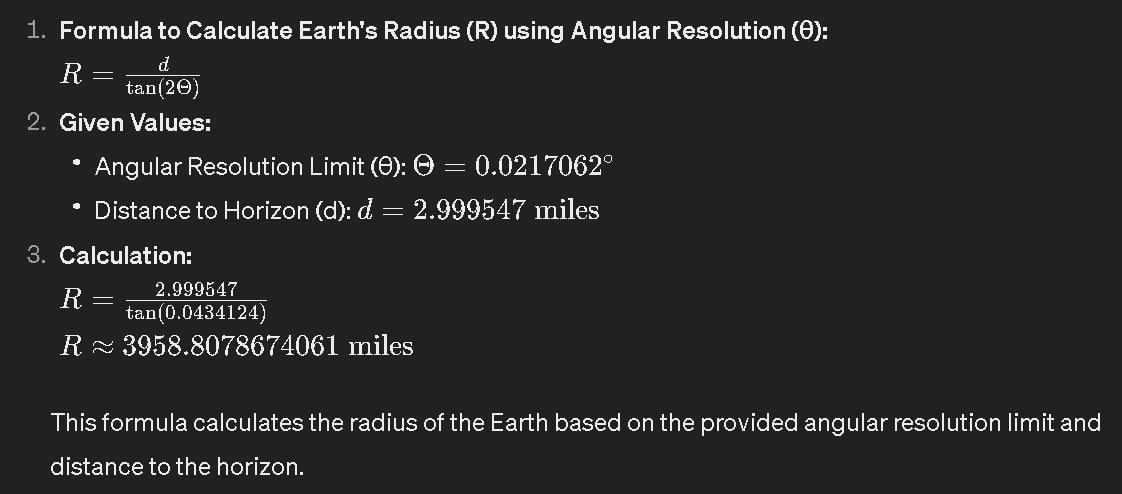




![[Library/Attachments/Pasted image 20240301005326.png]



**1. Drop Rate Calculation:** Given a drop of 1212 feet over 33 miles, the conversion from inches to feet introduces a constant (since 11 foot = 1212 inches), which is necessary for unit consistency:
- Drop rate per mile squared =8 inchesmile2×1 foot12 inches=23 feet per mile2=mile28inches×12inches1foot=32feet per mile2.
**2. Distance to Horizon Calculation:** The formula for calculating the distance to the horizon involves a constant (1.221.22) derived from geometric considerations and atmospheric refraction:
- Distance=1.22×6 milesDistance=1.22×6miles.
**3. Angular Resolution to Radius Calculation:** Utilizing the angular resolution (�θ) and the Rayleigh criterion necessitates the use of trigonometric functions, which are not constant-dependent but are functions of the given parameters:
- tan(�)=�3tan(θ)=3R, where �=0.000552θ=0.000552 radians for calculation.
**4. Deriving Angular Resolution from Radius:** To find angular resolution from a given radius without introducing unnecessary constants, we apply the tangent and arctangent functions directly to the radius and distance:
- �=arctan(�3)θ=arctan(3R), with �=3959R=3959 miles as given.

To derive the Earth's circumference from the angular resolution limit and the curvature rate of 8 inches per mile squared, we can follow these steps:
1. Start with the curvature rate of 8 inches per mile squared:
- The curvature rate of 8 inches per mile squared can also be expressed as 2/3 feet per mile squared, which is equivalent to 0.666 feet per mile squared.
2. Use the angular resolution limit of 0.0316° (or 0.000552 radians) to determine the drop rate:
- Given the angular resolution limit, we can relate it to the curvature rate to establish the drop rate over a distance for objects descending due to Earth's curvature.
3. Once you have the drop rate over distance, you can convert this information to calculate the Earth's curvature profile and determine the full circumference using appropriate geometric and trigonometric methods.
By integrating the angular resolution limit, Earth's curvature rate, and the connection between angular measurements and surface curvature, you can derive the Earth's circumference based on these optical aspects.
# Limit of Resolution: Rayleigh Criterion
When a point object is imaged using a circular aperture such as the lens or the iris of our eye, the image produced is not a point, rather a diffraction pattern. This is true, mainly when the size of the object is comparable to the wavelength of light.
A circular aperture creates a diffraction pattern of concentric rings that grow dimmer as we move away from the centre. These are known as **Airy discs**.
[Open: 701cef57f24b7659986b2895f8cc0683_MD5.jpg](https://publish.obsidian.md/shanesql/Attachments/701cef57f24b7659986b2895f8cc0683_MD5.jpg)
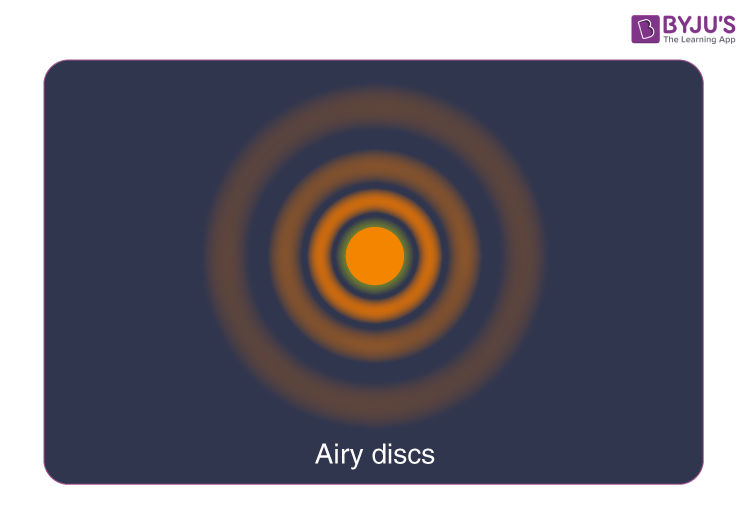
Because of the airy discs, point sources close to one another can overlap and produce a blurred image, as shown in the image.
[Open: e8fadc5b428862b9c6eb4b0ad68888f4_MD5.jpg](https://publish.obsidian.md/shanesql/Attachments/e8fadc5b428862b9c6eb4b0ad68888f4_MD5.jpg)
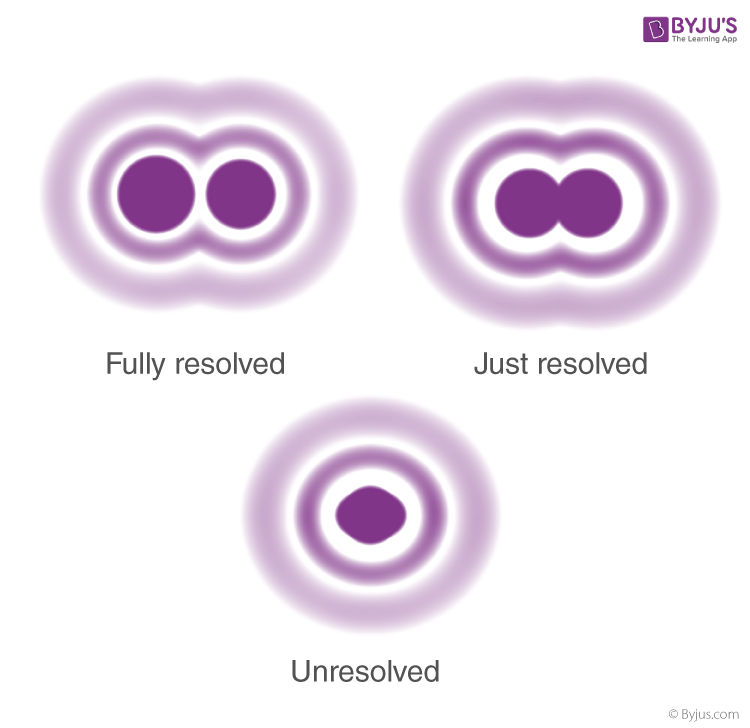
To obtain a good image, point sources must be sufficiently far apart that their [diffraction patterns](https://byjus.com/physics/single-slit-diffraction/) do not overlap. To achieve this, the minimum distance between images must be such that the central maximum of the first image lies on the first minimum of the second and vice versa. Such an image is said to be just resolved. This is the famous Rayleigh criterion.
## What is Rayleigh Criterion?
Consider the diffraction pattern for a circular aperture as shown in the figure below.
[Open: 156f619b011c58e8daa6bd7a2dbcea59_MD5.jpg](https://publish.obsidian.md/shanesql/Attachments/156f619b011c58e8daa6bd7a2dbcea59_MD5.jpg)
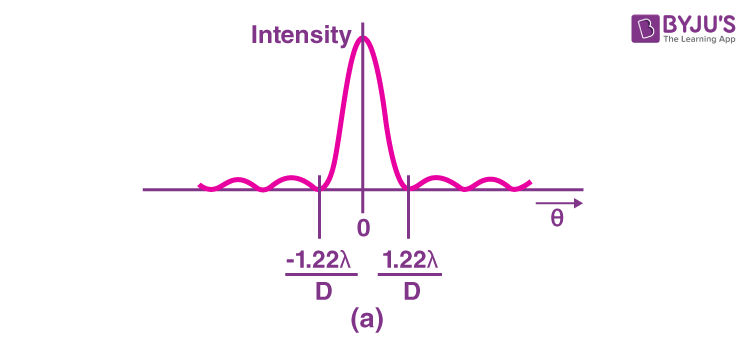
It can be shown that, for a circular aperture of diameter D, the first minimum in the diffraction pattern occurs at
Θ=1.22��
The accepted criterion for determining the diffraction limit to resolution based on this angle was developed by Lord Rayleigh in the 19th century.
“**Rayleigh criterion for the diffraction limit to resolution states that two images are just resolvable when the centre of the diffraction pattern of one is directly over the first minimum of the diffraction pattern of the other**.”
[Open: d97c2d41c160314448e21c69a5b996f0_MD5.jpg](https://publish.obsidian.md/shanesql/Attachments/d97c2d41c160314448e21c69a5b996f0_MD5.jpg)
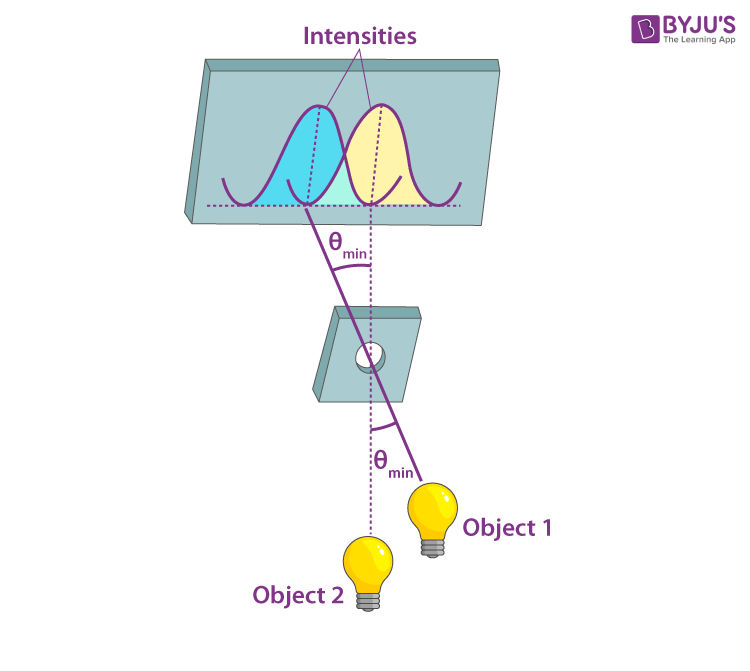
### Other ways to compute Rayleigh's

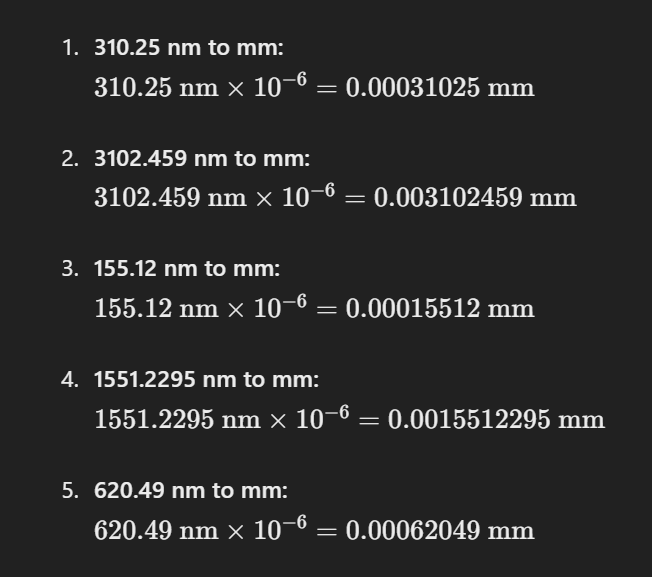
- **Example Pair 1:**
- Diameter, D=1 mm=1×10−3 mD = 1 \text{ mm} = 1 \times 10^{-3} \text{ m}D=1 mm=1×10−3 m
- Wavelength, λ=3.102459×10−4×1×10−3=3.102459×10−7 m=310.25 nm\lambda = 3.102459 \times 10^{-4} \times 1 \times 10^{-3} = 3.102459 \times 10^{-7} \text{ m} = 310.25 \text{ nm}λ=3.102459×10−4×1×10−3=3.102459×10−7 m=310.25 nm
- **Example Pair 2:**
- Diameter, D=10 mm=10×10−3 mD = 10 \text{ mm} = 10 \times 10^{-3} \text{ m}D=10 mm=10×10−3 m
- Wavelength, λ=3.102459×10−4×10×10−3=3.102459×10−6 m=3102.459 nm\lambda = 3.102459 \times 10^{-4} \times 10 \times 10^{-3} = 3.102459 \times 10^{-6} \text{ m} = 3102.459 \text{ nm}λ=3.102459×10−4×10×10−3=3.102459×10−6 m=3102.459 nm
- **Example Pair 3:**
- Diameter, D=0.5 mm=0.5×10−3 mD = 0.5 \text{ mm} = 0.5 \times 10^{-3} \text{ m}D=0.5 mm=0.5×10−3 m
- Wavelength, λ=3.102459×10−4×0.5×10−3=1.5512295×10−7 m=155.12 nm\lambda = 3.102459 \times 10^{-4} \times 0.5 \times 10^{-3} = 1.5512295 \times 10^{-7} \text{ m} = 155.12 \text{ nm}λ=3.102459×10−4×0.5×10−3=1.5512295×10−7 m=155.12 nm
- **Example Pair 4:**
- Diameter, D=5 mm=5×10−3 mD = 5 \text{ mm} = 5 \times 10^{-3} \text{ m}D=5 mm=5×10−3 m
- Wavelength, λ=3.102459×10−4×5×10−3=1.5512295×10−6 m=1551.2295 nm\lambda = 3.102459 \times 10^{-4} \times 5 \times 10^{-3} = 1.5512295 \times 10^{-6} \text{ m} = 1551.2295 \text{ nm}λ=3.102459×10−4×5×10−3=1.5512295×10−6 m=1551.2295 nm
- **Example Pair 5:**
- Diameter, D=2 mm=2×10−3 mD = 2 \text{ mm} = 2 \times 10^{-3} \text{ m}D=2 mm=2×10−3 m
- Wavelength, λ=3.102459×10−4×2×10−3=6.204918×10−7 m=620.49 nm\lambda = 3.102459 \times 10^{-4} \times 2 \times 10^{-3} = 6.204918 \times 10^{-7} \text{ m} = 620.49 \text{ nm}λ=3.102459×10−4×2×10−3=6.204918×10−7 m=620.49 nm
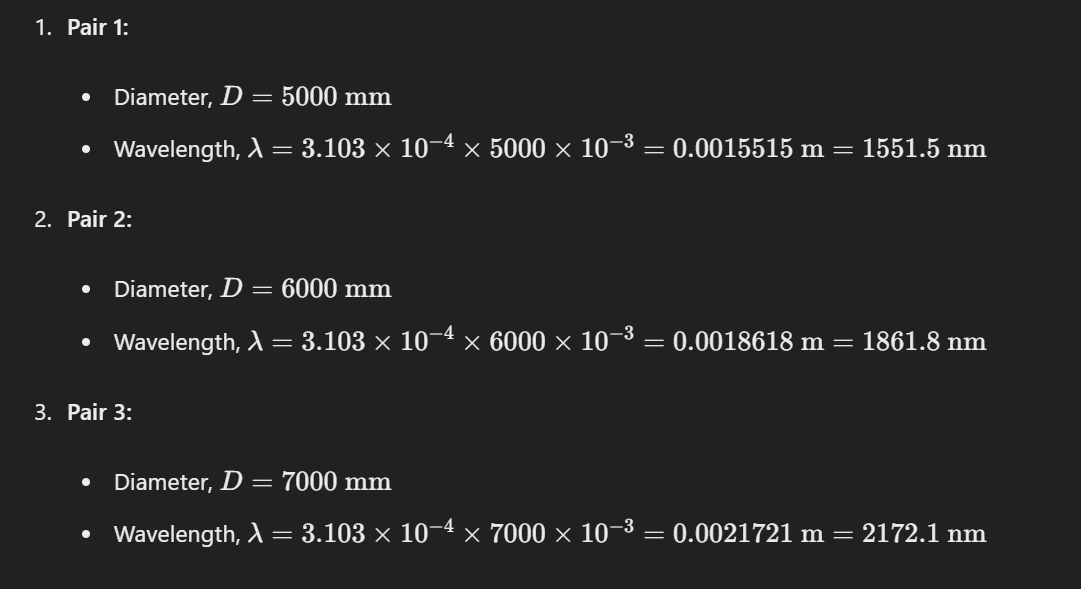
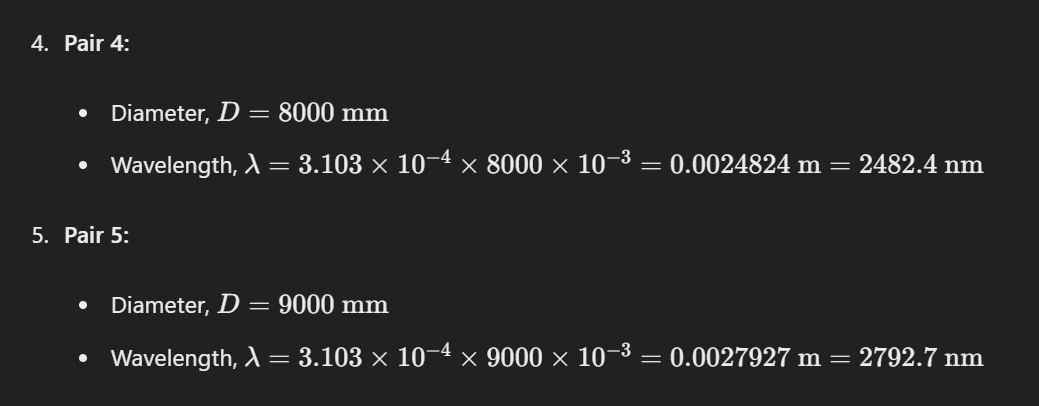
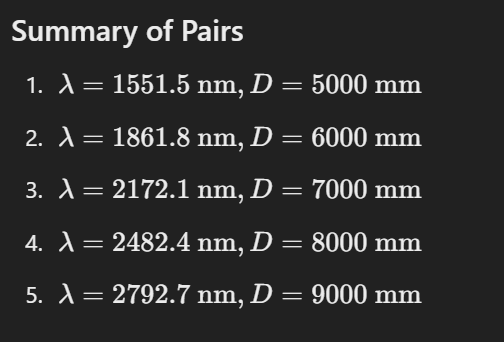
In the figure, the first minimum is at an angle
Θ=1.22��
So this means that two point objects are just resolvable if they are separated by an angle
Θ=1.22��
### Rayleigh Criterion Solved Example
The Hubble Space Telescope’s primary mirror has a diameter of 2.40 m. (a) Determine the angle between two just-resolvable point light sources? Assume the average wavelength of light as 550 nm.
**Solution:**
The Rayleigh criterion gives the smallest possible angle 𝜃 between point sources.
Θ=1.22��
Substituting the values in the above equation, we get:
Θ=1.22��
Θ=1.22220×10−9�2.40�=2.80×10−7�
## Resolving Power of Telescope
In telescopes, objects such as binary stars which are very close to each other, subtend small angles on the telescope. We need large apertures to resolve them. We can make use of Rayleigh’s Criterion to determine the resolving power of the telescope. The angular separation between two objects must be
Θ=1.22��
Resolving power is defined as the inverse of the distance or angular separation between two objects which can be resolved through the optical instrument. Therefore,
��������������=1ΔΘ=�1.22�
Thus, the higher the diameter d, the better the resolution. Astronomical optical telescopes have mirror diameters as large as 10 m to achieve the best resolution.
### Watch the video and learn how a telescope makes distant objects appear nearer.
[Open: 955dd2711848f5195eac400d8987c5c7_MD5.jpg](https://publish.obsidian.md/shanesql/Attachments/955dd2711848f5195eac400d8987c5c7_MD5.jpg)
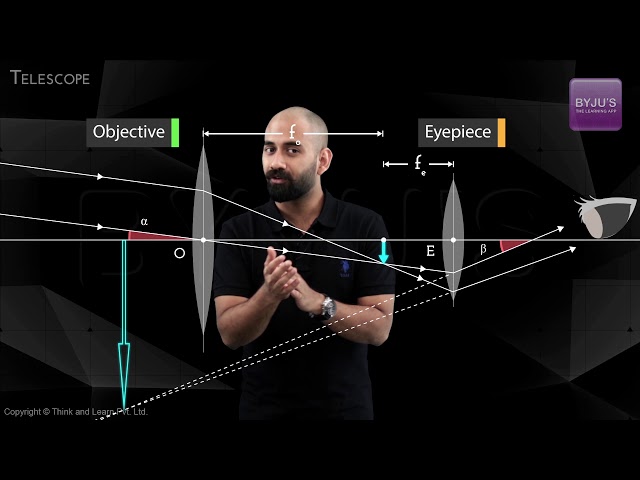
1,44,590
||
|---|
|**Similar Articles:**|
|- [Scattering of Light](https://byjus.com/physics/what-is-scattering-of-light/) <br>- [Interference of Waves](https://byjus.com/physics/interference-of-waves/) <br>- [Difference Between Diffraction and Interference of Light](https://byjus.com/physics/difference-between-diffraction-and-interference/) <br>- [Diffraction Grating](https://byjus.com/diffraction-grating-formula/)|
## Radius of Earth
To give you the average radius of the Earth to 10 decimal places:
- The equatorial radius is about 6,378.137 kilometers (3,963.191 miles).
- The polar radius is about 6,356.752 kilometers (3,949.903 miles).
The mean radius, which is one-third of the sum of twice the equatorial radius and the polar radius, is used by the International Union of Geodesy and Geophysics (IUGG) for the purposes of geophysics, and it's approximately 6,371.0008 kilometers.
Let's provide the mean radius to ten decimal places in kilometers. The exact value to ten decimal places may vary slightly depending on the source, but using the IUGG mean radius:
6,371.0008000000 kilometers
